Herschel's Ghosts
by Mel Bartels
Visual discovery of the Integrated Flux Nebulae (galactic cirrus) and InterStellar Medium (ISM)
The task isn't to see what's never been seen before, it is instead to think about what nobody has yet thought about that which everyone sees (adapted from Arthur Schopenhauer).
“Nothing ever becomes real ‘til it is experienced.” - John Keats
Check out my article in the April 2017 issue of Sky and Telescope Magazine, "Herschel's Ghosts". I share my visual discovery of Integrated Flux Nebulae and my investigation into little known observations of earlier visual observers extending all the way back to William Herschel.
Observe Integrated Flux Nebulae in a small telescope? Inconceivable! Always enamored of aperture and wide field, I began building F3 and faster Richest Field Telescopes in 2008. Never had I quite had views like these. First light with my newly minted 6 inch [15cm] F2.8 Richest Field Telescope yielded my re-discovery of the Pleaides Bubble. Second light brought me an unexpected mystery: M31 the Andromeda Galaxy extended not for three degrees but for five degrees with light trailing off from the edges and a shelf of nebulosity underneath the galaxy that I dubbed the Andromeda Shelf.
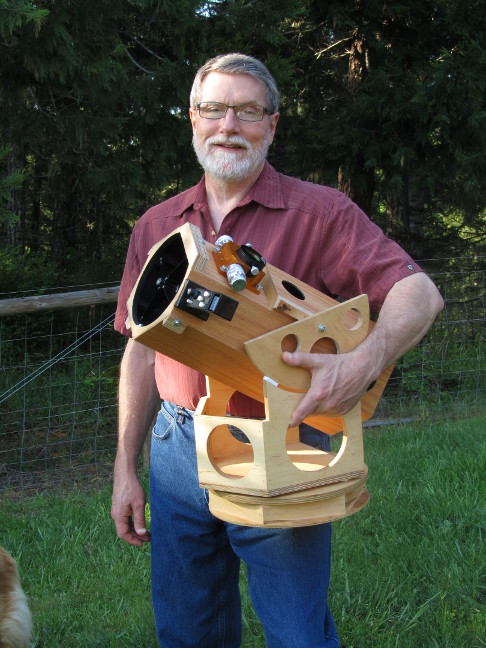
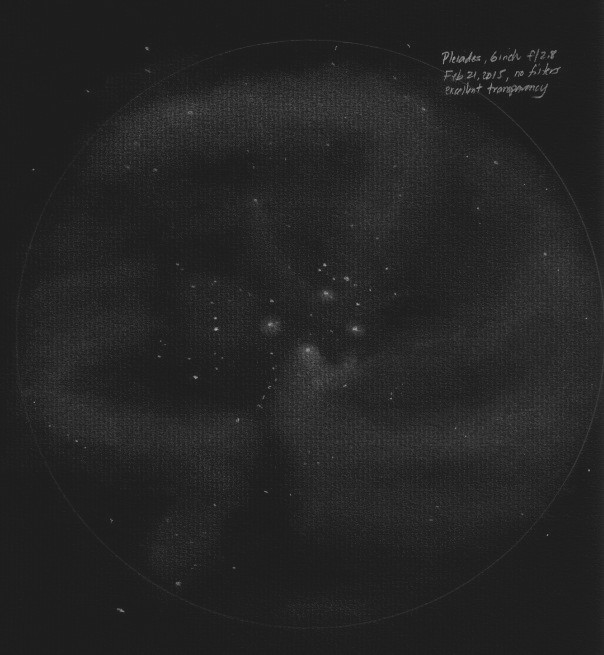
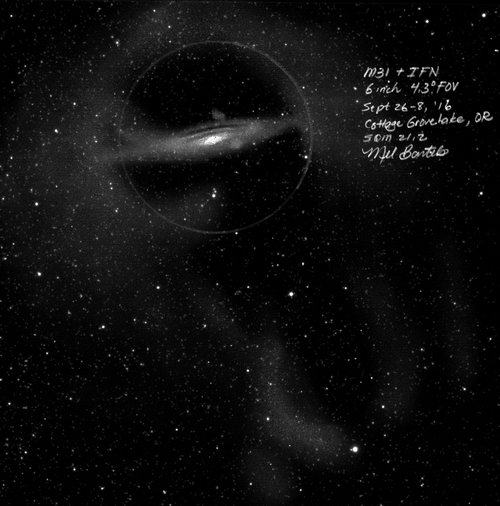
I sketched over two hundred dark nebulae and very faint extended objects like the Cone Nebula and the Wolf-Rayet shell, SH2-308.


In early 2016, I thought the impossible: to try observing IFN. I pointed my 10.5 inch [27cm] F2.7 telescope at M81/82. To my utter surprise the field was alive with faint broad nebulosity. Just...astonishing. The feeling of discovery alone in the dark is beyond words. A passage to an new universe opened, filled with faint gossamers of light. I devoted myself to researching and discovering IFN.
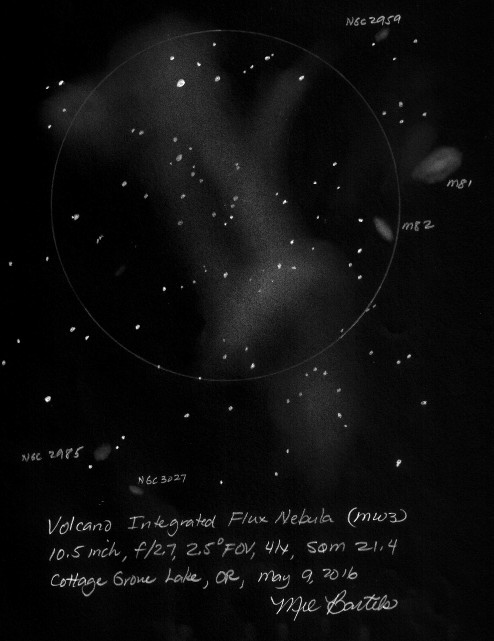
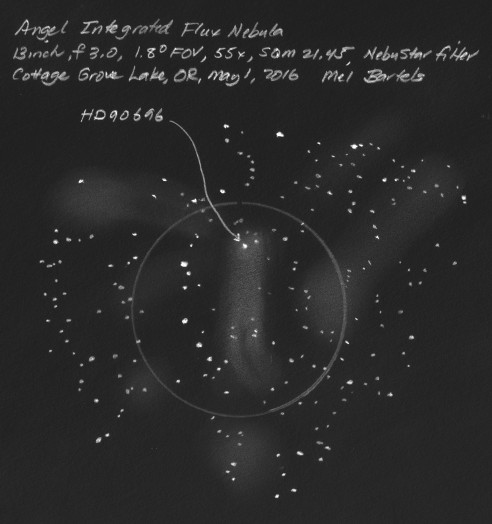
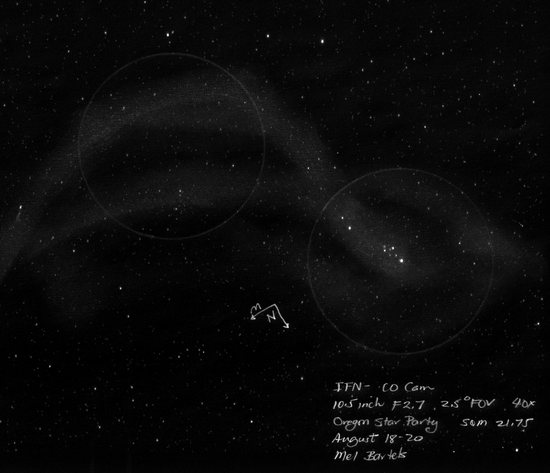
Dust and gas in the plane or disk of the Milky Way that resides between the stars is called the InterStellar Medium (ISM). Faint streamers of gas and dust that extend far above and below the galactic plane all the way to the galactic pole is called galactic cirrus or Integrated Flux Nebulae, since the dust glows dimly from the integrated light of countless millions of Milky Way stars.
How to observe IFN and ISM
The too long; didn't read bullet point version:
- A Richest Field telescope, capable of low power wide angle views at maximum exit pupil, with enhanced coatings. Aperture appears unimportant. Amateurs with binoculars and small refractors report successful observations of my IFN finds that I label 'medium' or 'bright'.
- Dark skies and I mean very dark skies.
- An observing process that emphasizes large scale low contrast objects.
Here's the longer elaborated version:
Why am I able to see IFN and ISM? First because I look for them. Much of what we see is guided by what we think we'll see. Think of the gorilla walking across the stage that no one notices.
Recently several experienced observers and I conducted a visibility test with three 10 inch [25cm] telescopes, an f5, an f3.8 and my f2.7. Each was equipped with an 80 degree eyepiece of different focal length so that each telescope had a matching exit pupil of 6mm pupil. We compared views of the Witch's Broom, a portion of the Veil Nebula. Our expectation was that all three telescopes would give the same view. The f5 and f3.8 telescope did give an identical view, but the f2.7's view was more vivid and brighter despite its larger central obstruction. The only differences we found was that the f2.7 had enhanced coatings and the 'insane' quality of the mirror. We went on to compare views of IFN next to M13 and M57 not only in these 10 inch scopes but also with an 8 inch binoscope, a 20 inch f5 and my newly minted 25 inch f2.6. We could see the IFN to varying degrees in all the telescopes. For the monocular telescopes, the only factor that correlated with the detectability of the IFN across this wide range of apertures and telescopes was exit pupil: the greater the exit pupil, the more visible the IFN. The f2.7 scope with a 100 degree eyepiece showed a greater extent of IFN with more 'wow' and I think more discoverable but no additional contrast beyond what was seen in the 80 degree eyepiece. The 8 inch binoscope gave contrasty views nearly equal to the 25 inch despite its smaller aperture. Go here for more on Richest Field Telescopes and here for more on High Etendue Telescopes.
Alan Sandage analyzed the brightest portions of the IFN to be 24.5 mag/arcsec^2. If you observe from 21.4 mag/arcsec^2 skies, then you have a 6% contrast ratio, sufficient to see the IFN and dimmer detail when magnified to fit a very wide angle apparent field eyepiece. My observations suggest that only the brightest portions of the IFN can be seen when the sky is at 21 mag/arcsec^2. IFN visibility depends critically on very dark, contrasty, transparent skies. Here are two sketches of IFN near M64, one at SQM 21.1 and one at SQM 21.4, illustrating the overwhelming impact of dark skies.
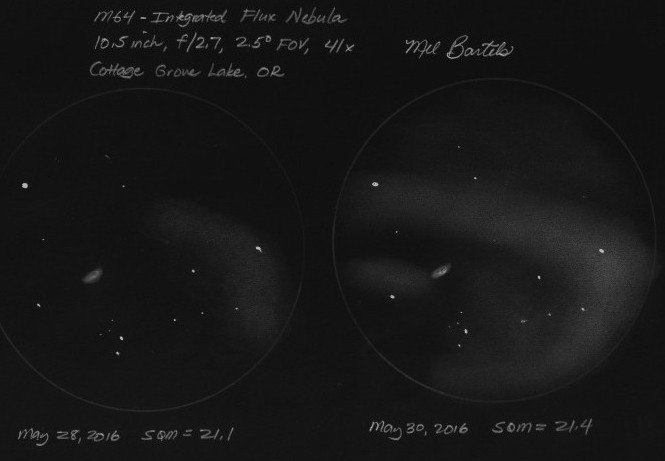
I have developed observing processes for IFN. These are key to exploring regions for potential IFN. My lowest power eyepiece with 100 degree apparent field of view allows me to search back and forth, using averted vision, to locate brighter and darker areas and their boundaries. Tighter eye movements yield smaller and more detailed detections. For very large objects, I also move the scope. This 'shakes lose' larger scale objects. For extremely large-scale objects, I identify a portion of the object and then follow it across many fields of view, noting star asterisms along the way. I then return back to the starting point and repeat a couple of times, building both a mental visual image and adding to my pencil sketch where I highlight the asterisms, boundaries, brightnesses and shapes. I use a pre-printed star chart of the area to draw on and then later draw a new sketch that includes the asterisms and any IFN that I found. It helps significantly to return for a fresh look on the subsequent night. Which observing process I use, for example, small-scale detail or many field, preferentially selects for particular IFN.
I use a 6-7mm pupil. I’ve not found 3-4mm pupils as useful: it as if the smaller pupils act to stop down the telescope, lowering the etendue of the field. I almost never use filters: occasionally a deep sky filter like DGM's NPB or Orion's SkyGlow will help marginally.
Here are three sketches of IFN near M51, the Whirlpool Galaxy, with a 6 inch, 13 inch and 25 inch. I can see more detailed IFN with the larger aperture; the wider scale IFN is visible in the small scope.
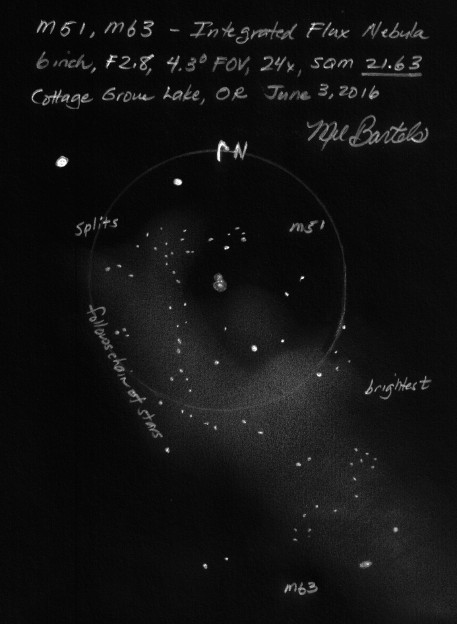
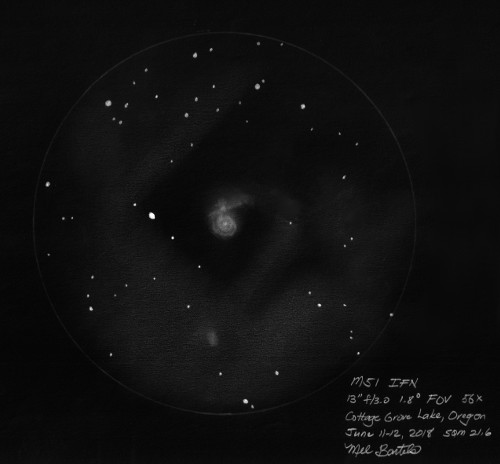
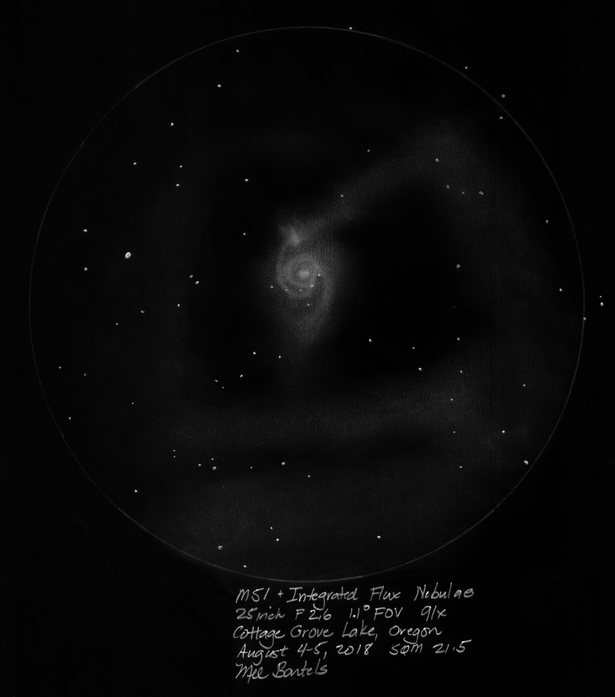
Another example of increasing aperture on visibility of IFN, this time the clouds of Andromeda Galaxy (to be sure, these clouds are in our Milky Way galaxy). Note that I turned the first drawing upside down for easier comparison. As with the M31 example, the larger scope breaks up the broad bands into clouds and streaks.
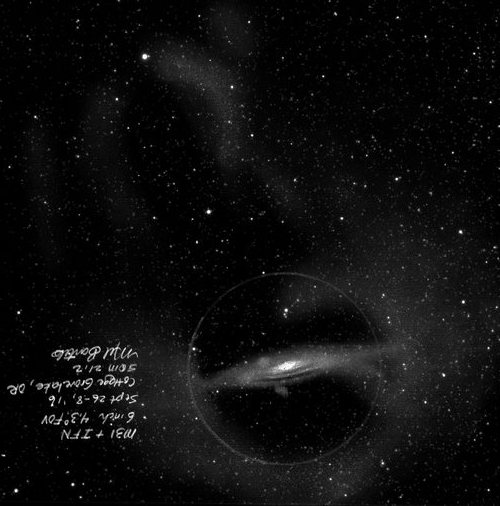
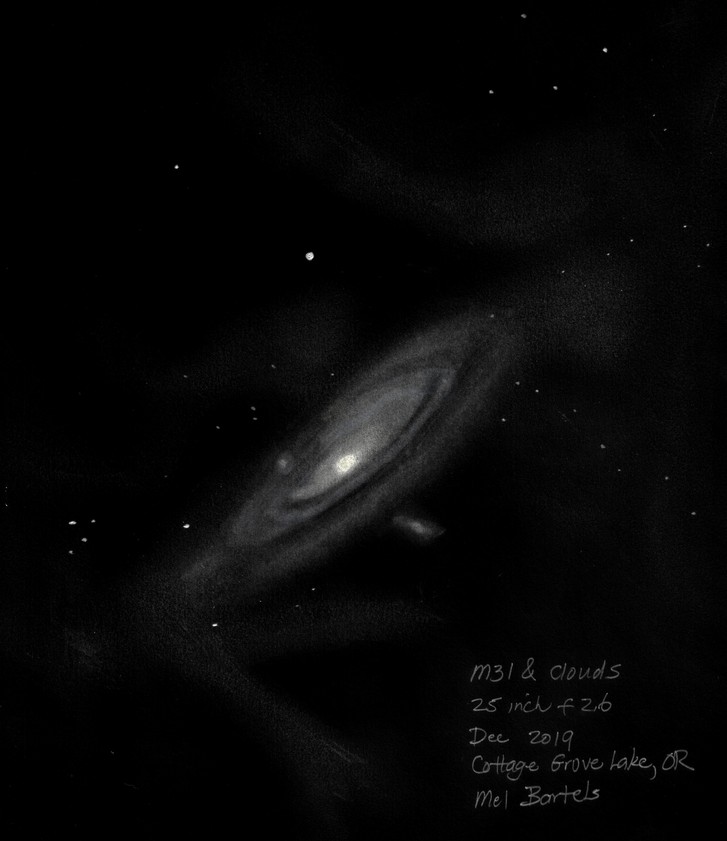

Comparing IFN near M74 through 6 inch, 13 inch and 30 inch scopes is interesting.

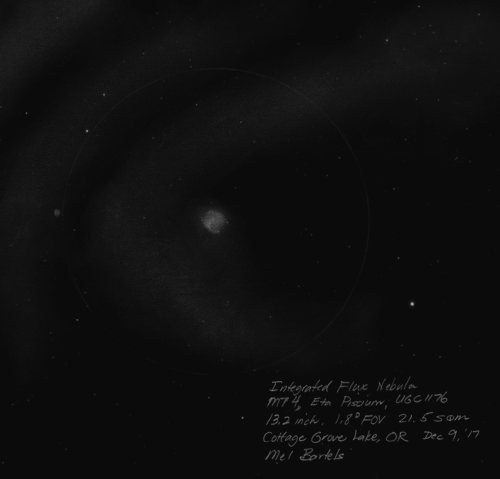
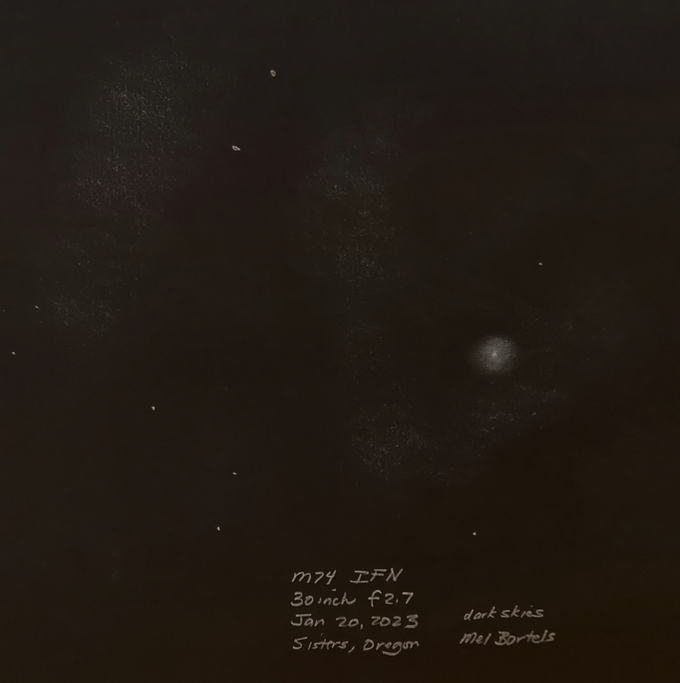
With practice I have become much better: what was once hard is now clearly visible. Start with the brightest IFN in my catalog, then find your own as you gain skill. Share views with others. Dozens of observers from experienced to beginner at the Oregon Star Party have seen IFN and ISM through my telescopes.
Binocular and unaided-eye observations
Since visual detection is a matter of contrast and the object's apparent size, I hypothesized that I should see IFN with binoculars and even with my unaided-eyes. Indeed, this is the case. Using 7x50 binoculars, I was able to see the broad outlines of the first two sketches done with my small telescopes. The last sketch is an unaided-eye view of the Polaris to M81/82 IFN. This view reminds me of experienced observers at the Oregon Star Party years ago stating that they could see the Milky Way extend to and past Polaris.
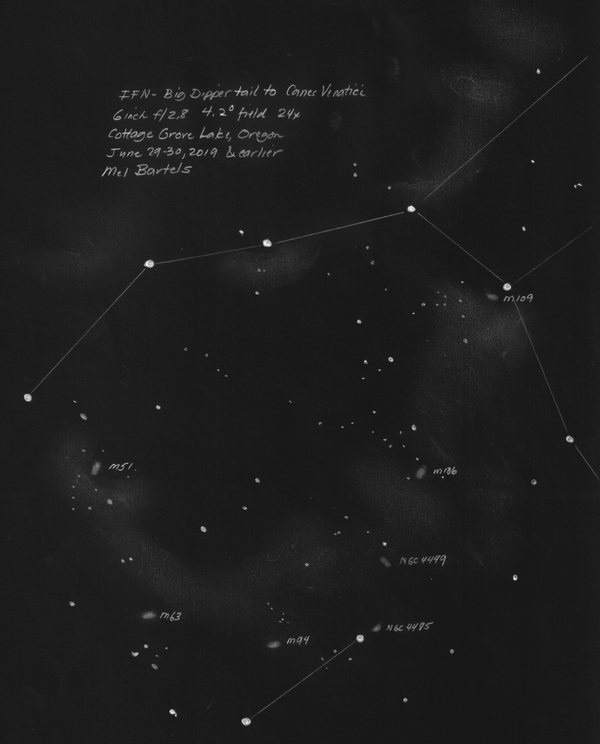
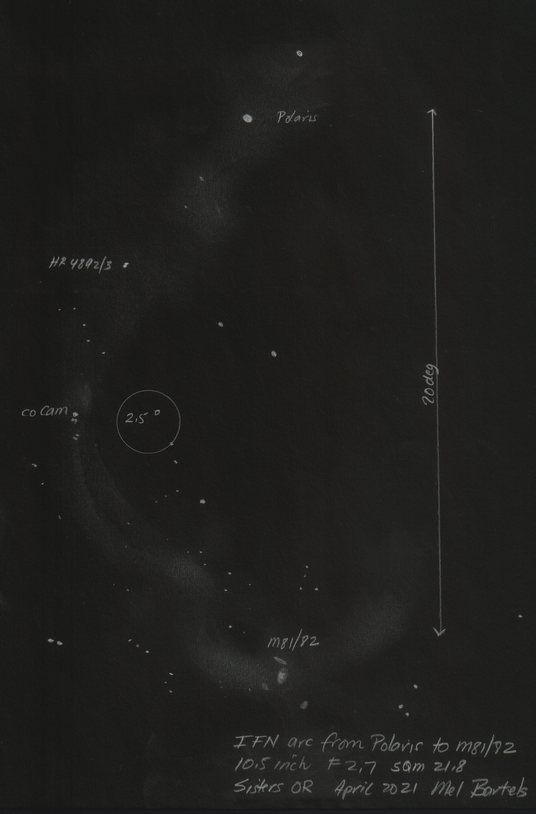
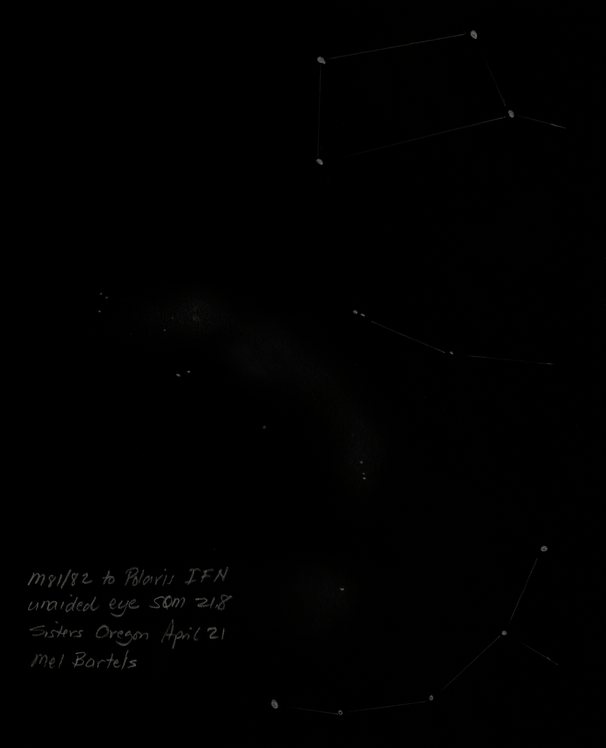
Rarely an imager will take a deep image of an area that I have previously sketched. Without exception the broad strokes match though the digital image will miss some broader areas while catching finer scale structure. I consider my sketches more definitive than images because almost all imagers use filters and heavily process their images, suppressing background glow to avoid noise.
Where to start? Here are the brightest IFN from my catalog below.
Here are the largest IFN structures that I have sketched.
I don't believe your sketches because these structures only show up on very long exposure digital images
I hear this argument from time to time.
- First of all, Ive seen and sketched these structures; I have shown IFN/galactic cirrus to dozens while looking through my scopes. And other observers equipped with wide field telescopes report seeing these structures on forums.
- Secondly, comparing processed digital images to visual sketches is a non sequitur.
- Thirdly, our eyes are exquisitely sensitive detectors. The eye can detect 6-10 photons, rarely down to a single photon. If IFN/galactic cirrus glow at 25.5 magnitude per square arc-second, and given a dark sky, then our eyes are capable of detecting 2-3% contrast. These numbers compare favorably with digital imaging chips.
- Fourthly, it is not true that these structures are detected only with very long exposure digital images. I've found numerous not-heavily-processed much shorter exposure images on the web, then reprocessed them. The structures appear! They are grainy and certainly not aesthetically beautiful. Plus they can look like background problems such as unequal illumination. It is understandable that imagers process out IFN/galactic cirrus.
- Lastly, what to do with the strong bias that we have to not believe in something if we haven't seen it ourselves? I find this a particularly difficult bias to overcome. Slowly over the years, while observing with experienced observers, I have learned that they see what I see, that they don't see what I don't see. I now rely on their observations even when I haven't made that observation myself.
All-sky IFN sketch
I now look for IFN just beyond IFN I've already discovered. Astonishingly, I'm seeing suggestions of very long sequences of IFN stretching for dozens of degrees across the sky. In fact, I can almost hop from the summer Milky Way to the winter Milky Way in the spring sky. I re-sketched all my spring IFN sketches on a printout of the spring sky. The vast majority of these sketches are themselves multi-field sketches using my 6 inch, 10.5 inch, 13.2 inch and 25 inch high etendue Richest Field Telescopes. While my all-sky sketch of the spring sky is far more incomplete than complete, meaning that there are vast areas that I have not investigated where IFN might lurk, I find that tracing IFN that I've discovered so far clear across the sky simply awe-inspiring and mind-boggling.
Click or tap on the image for the fullsized version.

Historical observations
Arndt Latussek describes the fascinating history of personal discovery followed by community disbelief with William Herschel in the late 1700's, Father Johann Hagen, Director of the Vatican Observatory in the 1920's and Marcel de Kérolyr in the 1930's. Other observers include Hermann Goldschmitt who discovered the Pleiades Bubble in 1863, Baron Renaud de Terwangne who observed IFN from 1934-1954 and Walter Scott Houston who mentioned the Pleiades Bubble in an early Sky and Telescope Gleanings article.
Herschel compiled a catalog from 1783 to 1811 of 52 nebulous regions where he observed the sky's 'floor' to be brighter than adjoining areas. His catalog included the Horsehead Nebula (discovery commonly attributed to Willamina Fleming, one of Pickering's 'computers' in 1888 and popularized by E.E.Barnard's astrophotography in 1894), the North American Nebula, Barnard's Loop and the IFN near M81 and M82. He came to believe by the end of his life that the sky was filled with nebulous material. Neither his son John Herschel, nor John Dreyer (author of the New General Catalog), chose to include Herschel’s nebulosities in their catalogs. Thus Herschel’s diffuse areas became historical and observational ghosts.
A century passed with no mention of Herschel's nebulous objects. Perhaps no one managed to build telescopes equal to Herschel's.
During the early part of the 20th century, Herschel’s catalog was surveyed visually by the Austrian-American Jesuit astronomer, Johann Hagen, Directory of the Vatican Observatory in Rome. In 1893, while observing double stars he incidentally noticed ‘cosmic clouds’ using the 6 inch F15 refractor. He eventually claimed to have observed all 52 of Herschel’s nebulae; results that met with derision because his clouds were not photographically detectable. Hagen continued to compile his faint clouds up until his death, coming to believe that faint clouds cover much of the night sky. Hagen was a true visual observer, favoring the visual record over photographs, saying that many hours of long exposures couldn’t match watch he could see in minutes. He advised astronomers to put away their cameras and look through the telescope, lamenting that visual skills were a dying art.
Isaac Robert’s widow, the leading French astronomer Dorothea Klumpke Roberts, collaborated with Hagen, perhaps to resuscitate her famous husband’s reputation, which had suffered with his harsh criticism of Herschel's observations. Her photographs received attention and applause. Even Edward Hubble, a sharp critic of Hagen, in a turnabout, suggested more photographs. With Hagen’s death in 1930, interest in Herschel’s and Hagen’s observations ceased. The astronomical world lost this fascinating thread reaching back to Herschel, one of humanity’s greatest visual observers.
The French amateur Marcel de Kérolyr, one of the greatest astrophotographers of all time, well known violinist, whose home the American dancer Isadora Duncan left only to suffer her fatal accident, but unknown today, became involved, successfully photographing some of Herschel objects and publishing visual observations of most of them. His astrophotos were published by Jean Giono, author of the wonderful The Man Who Planted Trees.
Baron R. de Terwangne was an accomplished double star, lunar and planetary observer. His planetary sketches are quite beautiful. He began observing extremely faint nebulous regions in 1929, later publishing a map that illustrated his astonishing observations that the IFN form streamers perpendicular to the galactic plane.
In looking at my drawings, I find matches to the following Herschel regions: 7, 8, 9, 10, 11, 12, 25, 27, 32, 34, 42, 48, 51 and 52.
References
Andreo, Rogelio Bernal, RBA Premium Astrophotography. http://www.deepskycolors.com/
Baron Renaud de Terwangne's observations and comments. http://articles.adsabs.harvard.edu//full/1946C&T....62..272D/0000272.000.html
Bartels, Mel, Observing Dark Nebulae. https://www.bbastrodesigns.com/dneb/Observing Dark Nebulae.html
Bartels, Mel, Newtonian reflecting Telescope designer. https://www.bbastrodesigns.com/NewtDesigner.html
GaBany, R.J., Integrated Flux Nebulae Surround Our Galaxy. http://www.cosmotography.com/images/galactic_cirrus.html
DragonFly Telescope Array comment about galactic cirrus. https://jgroub.wordpress.com/2017/04/15/april-14-2017-the-dragonfly-telephoto-array-galactic-formation-and-dark-matter/
Hommage a Mercel Bonnemain de Kerolyr, https://www.youtube.com/watch?v=UGGPi0WtEbY (2015)
Hughes, Stephen, Catchers of the Light, the Forgotten Lives of the Men and Women Who First Photographed the Heavens (2015)
Kato, Hisayoshi, Flickr stream, https://m.flickr.com/#/photos/hiroc/6754827529/
Latussek, Arndt, William Herschel’s Fifty-Two Fields of Extensive Diffused Nebulosity – A Revision. Journal of Astronomical History and Heritage, 11(3), 235-246 (2008) https://adsabs.harvard.edu/full/2008JAHH...11..235L
Lombry, Thierry, Les cirrus et les nebuleuses de flus integre (IFN) http://www.astrosurf.com/luxorion/univers-cirrus-ifn.htm
Mandel-Wilson, Unexplored Nebulae Project. http://www.aicccd.com/archive/aic2005/The_unexplored_nebula_project-smandel.pdf (2005)
Microsoft, World Wide Telescope. http://www.worldwidetelescope.org/webclient/ (e.g., the Plank thermal map)
My online catalog of IFN
Here are nearly 160 likely IFN, distinguished by their angular distance from the Milky Way. Occasionally I use a single multi-field mosaic sketch that covers more than one IFN. Click on the images to get the full sized sketches.
Pegasus Square - east side
RA 00:10 Dec 22:00
Size 4x12 deg
Visibility: medium
Description: Large curved region that splits in two as it curves to the SW; subtle detail
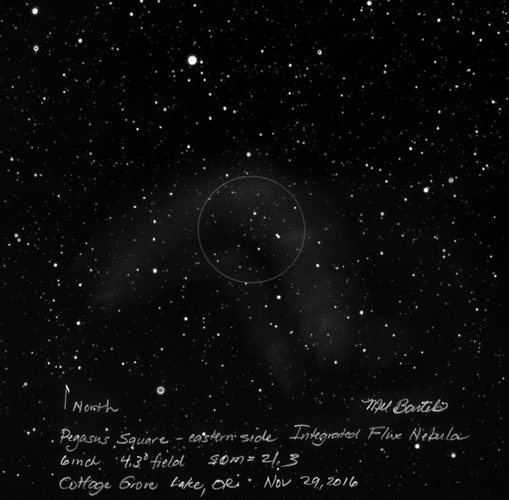
M31 Andromeda Galaxy dagger
RA 00:20 Dec 40:45
Size 1/3x2 deg
Visibility: medium
Description: Dagger shape to the west of M31; splits into two at the northerly end.

NGC 147 NGC 185
RA 00:35 Dec 48:40
Size 2x2 deg
Visibility: faint
Description: streaks with some clumpiness through the field of NGC 147, 185.
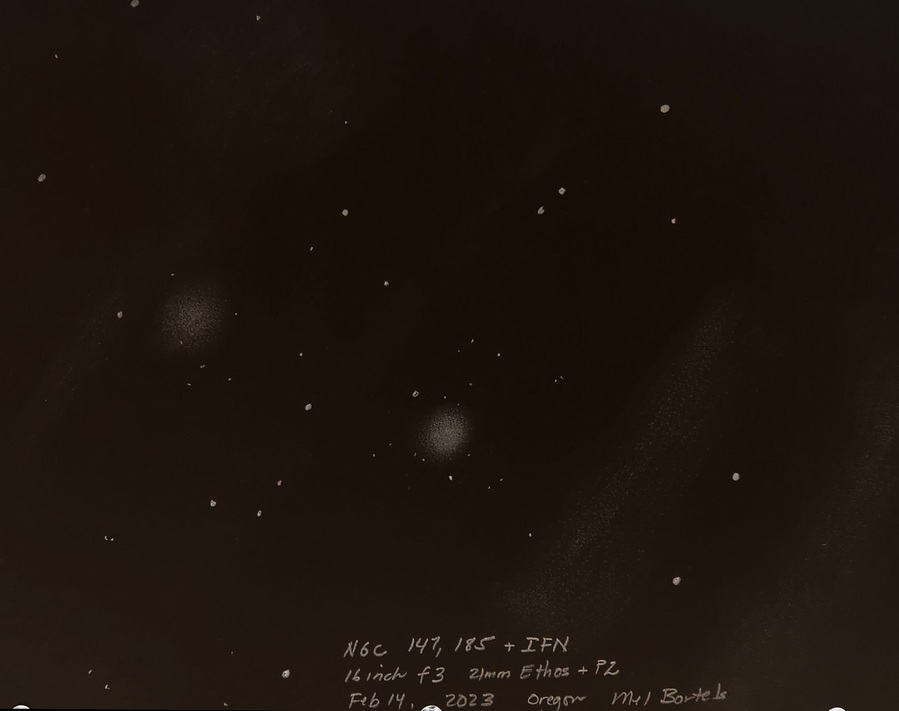
M31 Andromeda Galaxy comma
RA 00:40 Dec 41:40
Size 1/2x1 deg
Visibility: medium
Description: Comma shape to the west of M31 and M110.

M31 Andromeda Galaxy arch
RA 00:40 Dec 40:50
Size 1x1 deg
Visibility: faint
Description: arch shape near western end of M31 that arcs to the southeast.

M31 Andromeda Galaxy drop off
RA 00:40 Dec 40:30
Size 1x1 deg
Visibility: faint
Description: western extension of M31.

M31 Andromeda Galaxy
RA 00:45 Dec 41:00
Size 5x3 deg
Visibility: bright
Description: Shelf below M110; sides extend to edges of M31, confusing Andromeda Galaxy's size (possible explanation for reports that vary from 3 to 5 degrees wide); there's a curved arc to the southeast that almost completes a circle of IFN around the galaxy; the deflected arm to the northeast extends to the IFN making me suspect that the deflected arm is actually an extension of the IFN. Herschel region 7.

M31 Andromeda Galaxy eastern side northern arc
RA 00:46 Dec 42:40
Size 1/4x1/2 deg
Visibility: faint
Description: arc on eastern side of M31 that extends northward.

M31 Andromeda Galaxy eastern side northeastern blob
RA 00:49 Dec 42:20
Size 1/2x1/2 deg
Visibility: mediumn
Description: blob to east of M31.

M31 Andromeda Galaxy Nu Andromedae
RA 00:50 Dec 41:10
Size 1/4x1 deg
Visibility: faint
Description: Serpentine cloud between M31 and Nu Andromedae.

M31 Andromeda Galaxy NE of Nu Andromedae
RA 00:52 Dec 41:50
Size 1/2x1 deg
Visibility: faint
Description: Arc to NE of Nu Andromedae.

Beta Andromedae
RA 1:00 Dec 38:40
Size 1x2 deg
Visibility: bright
Description: Brighter patch of roughly parallel IFN bands that stretch from M31 to M33. Herschel regions 8 and 10 (region 9 is a duplicate of 10).

Eta Ceti
RA 1:10 Dec -10:00
Size 2x6 deg
Visibility: faint
Description: Broad complex arc with brightest portion to the immediate NW of the group of stars next to Eta Ceti and a wall of stars ~4 deg further to the NW; there's a portion that detaches and heads directly E
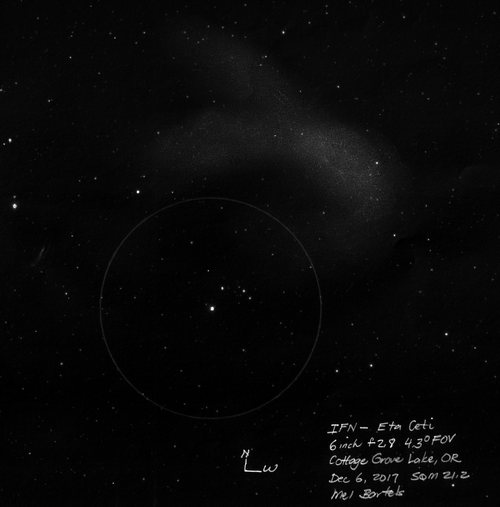
M33 to M31 stream
RA 1:10 Dec 35:30
Size 10x2 deg
Visibility: medium, varies
Description: M33 sits in a bowl of IFN, really awash in faint glows that coalesce then head up to M31, passing just to the each of Mirach (Beta Andromedae), connecting to the complex of IFN that surround M31 and its companion galaxies
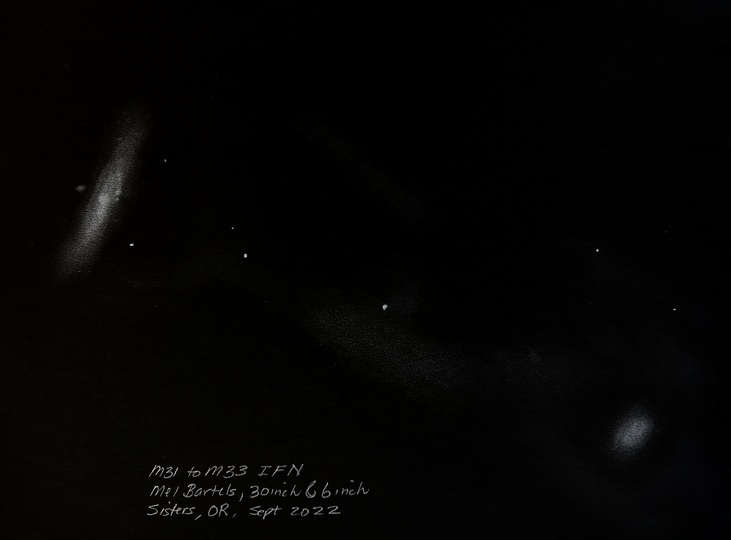
Donatiello 1
RA 1:13 Dec 35:00
Size 1x2 deg
Visibility: medium
Description: Broad glow to the south of Donatiello 1 with a faint finger that almost reaches the dwarf galaxy
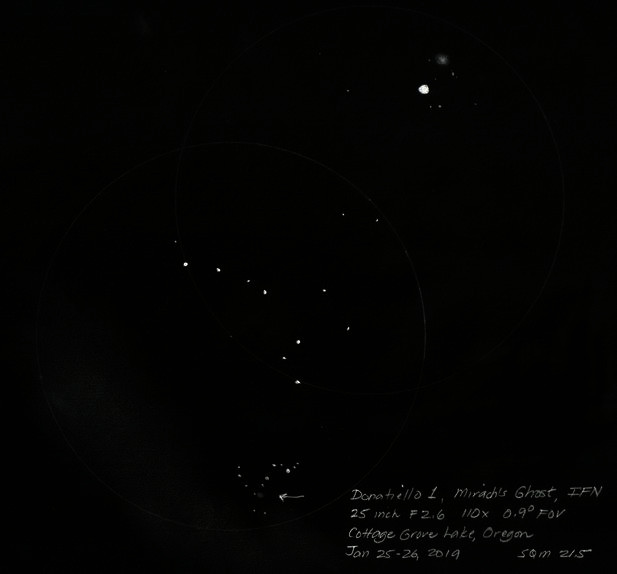
Upsilon Piscium, a few degrees from M33
RA 1:20 Dec 27:00
Size 2x6 deg
Visibility: medium
Description: three streaks centered on Upsilon Piscium.
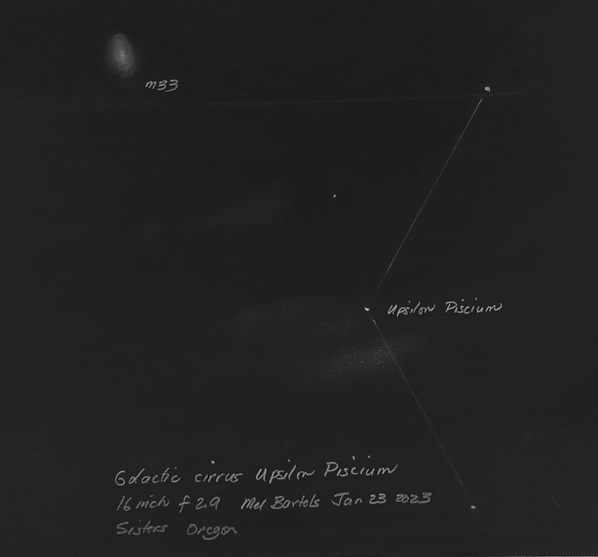
east to north of M33
RA 1:23 Dec 33:00
Size 1x6 deg
Visibility: dim
Description: large north/south band that curves from the east of M33 to the north; fainter bands to the north and south.
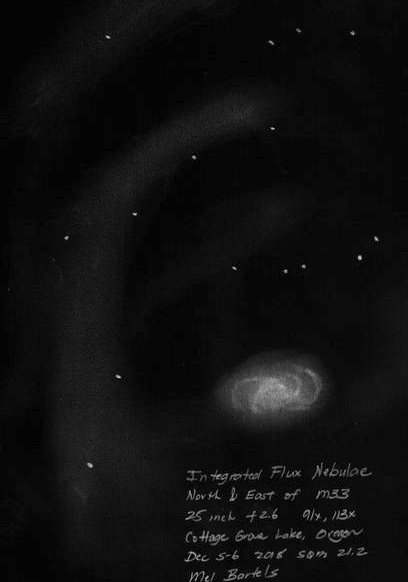
M33 bridge
RA 1:30 Dec 30:10
Size 1x4 deg
Visibility: bright
Description: Wall with bridge to M33. Herschel region 11.
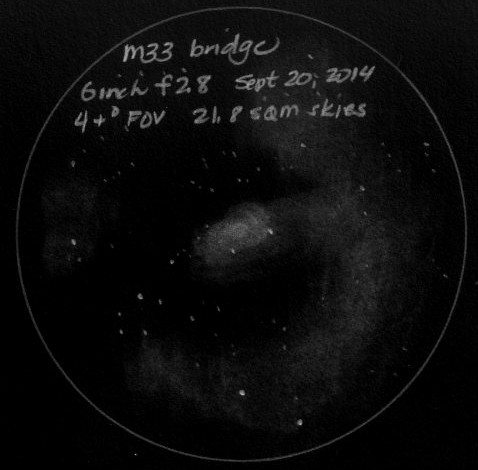
M74 with 30 inch
RA 1:30 Dec 15:30
Size 2x3 deg
Visibility: medium
Description: M74 detail on a night of excellent transparency; spiral arms noticeable as well as the nearby NGC 1167; IFN faintly envelopes M74 to the S and E then more faintly nearly to Eta Piscium, then more brightly cuts an arc to the E of M74 which is banded twice further E. Nice juxtaposition of Milky Way stars, M74 galaxy and IFN.

M74 with 13 inch
RA 1:30 Dec 15:30
Size 2x3 deg
Visibility: medium
Description: M74 detail on a night of excellent transparency; spiral arms noticeable as well as the nearby NGC 1167; IFN faintly envelopes M74 to the S and E then more faintly nearly to Eta Piscium, then more brightly cuts an arc to the E of M74 which is banded twice further E. Nice juxtaposition of Milky Way stars, M74 galaxy and IFN.

M74 & Eta Piscium
RA 1:30 Dec 15:30
Size 2x6 deg
Visibility: faint
Description: Immediately noticeable are the arc extending to the NW and M74 to the E; after studying the region the arc reveals subtle detail at right angles; in the end an intriguing view with the stars, galaxy and IFN, albeit faint and without delineation.

Beta Arietis
RA 2:00 Dec 2:00
Size 20:00 deg
Visibility: medium
Description: Round IFN brightening towards center.

NGC 918
RA 2:25 Dec 18:30
Size 1/2x1/2 deg
Visibility: faint
Description: 'V' shape. Herschel region 12.
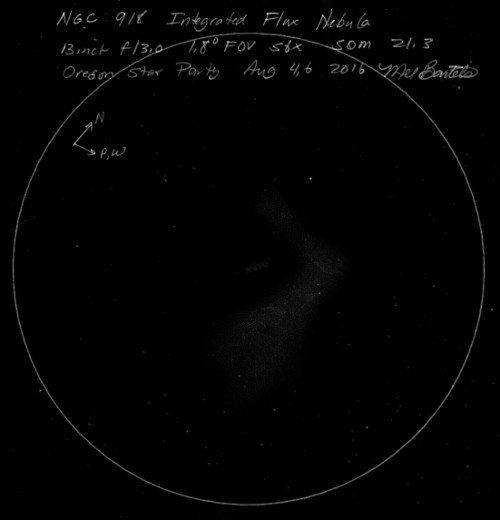
Aries: alpha to 41
RA 2:30 Dec 25:00
Size 2x10 deg
Visibility: medium
Description: Winding river of nebulosity from south of Alpha Arietis all the way to 41 Ari starting as a bright round area then indistinctly wandering, breaking into branches just before 41 Ari.
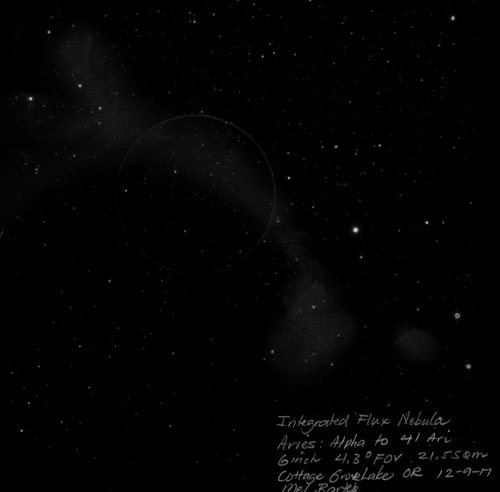
Polaris IFN
RA 3:00 Dec 88:00
Size 1x5 deg
Visibility: faint
Description: Brightest portion adjacent to Polaris; curved on past ending in blob 4 deg distance.
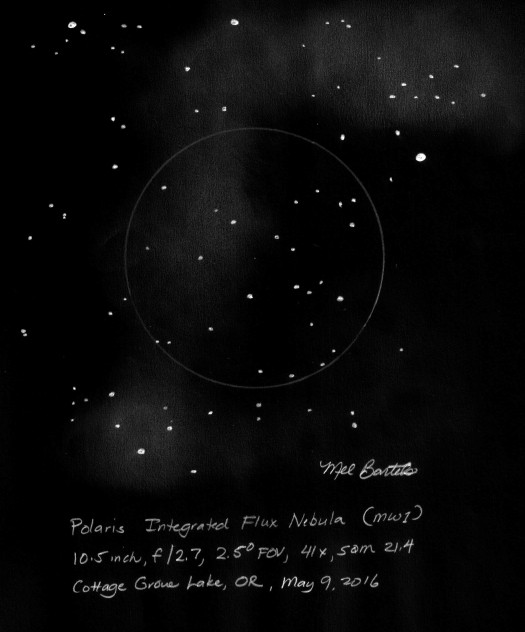
Pleiades streak to the west
RA 3:30 Dec 25:00
Size 1x5 deg
Visibility: medium
Description: streak extending to the west of the Pleiades.
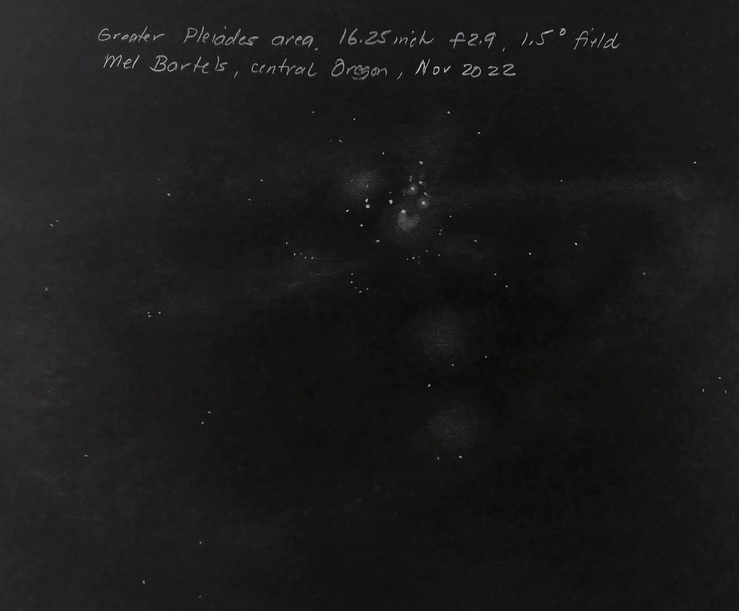
Pleiades connector between streak to the west and blob #2
RA 3:30 Dec 23:00
Size 1x5 deg
Visibility: medium
Description: connector between streak to the west and blob #2.

Pleiades
RA 3:45 Dec 24:00
Size 4x4 deg
Visibility: medium
Description: Bubble surrounding Pleiades with brighter elongated arcs; a fainter side arc to the Taurus IFN complex.

Pleiades blob #1 to the south
RA 3:45 Dec 21:30
Size 1x1 deg
Visibility: medium
Description: first blob to the south of the Pleiades.

Pleiades blob #2 to the south
RA 3:45 Dec 20:00
Size 1x1 deg
Visibility: medium
Description: second blob to the south of the Pleiades.

Pleiades twin connectors to the huge arc to the southeast
RA 4:10 Dec 21:00
Size 4x5 deg
Visibility: faint
Description: twin connectors to the huge arc to the heast of the Pleiades.

Pleiades huge arc to the southeast
RA 4:10 Dec 21:00
Size 3x8 deg
Visibility: faint
Description: huge arc with hints of detail to the southeast of the Pleiades.

Castor and Pollux area
RA 7:45 Dec 30:00
Size 1x5 deg
Visibility: medium
Description: Fairly bright and well defined spike perpendicular to the Milky Way that broadens into a diffuse area that curves south into a slightly brighter area.
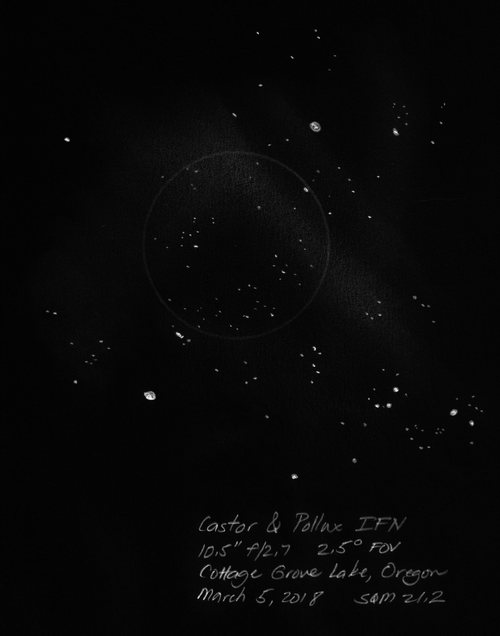
DU Lyncis
RA 7:45 Dec 37:00
Size 1x1 deg
Visibility: faint
Description: faint blob with some delineation of shape.
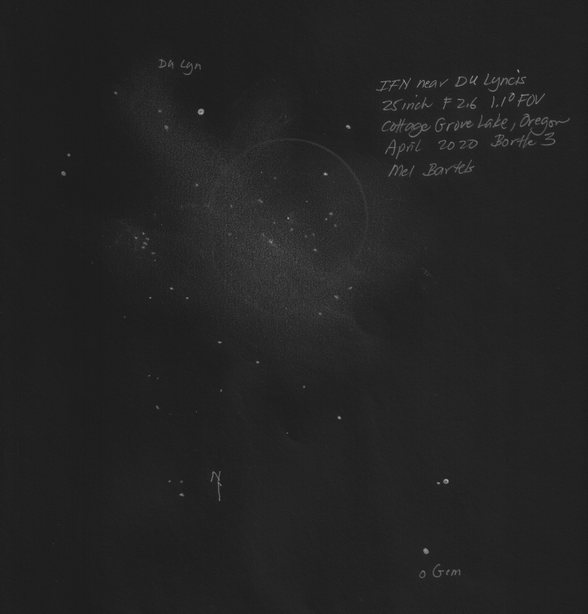
Phi2 Cancri between Beehive and Gemini
RA 8:30 Dec 27:00
Size 1x3 deg
Visibility: medium
Description: Spike with enclosing dark nebula.
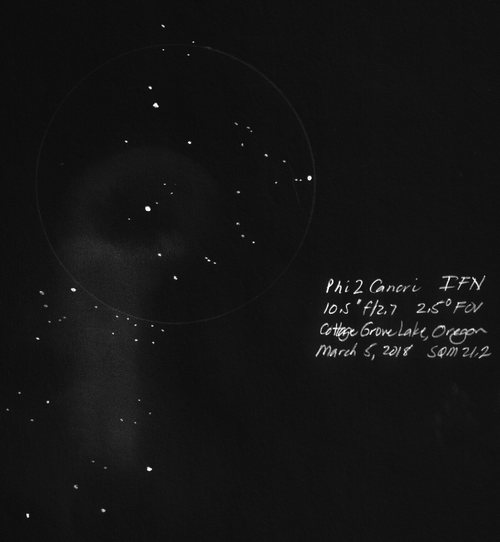
M44
RA 8:40 Dec 20:00
Size 1x3 deg
Visibility: faint
Description: Brightest to E of M44 with very faint extension into the core of the cluster.

Arp 80
RA 8:50 Dec 74:00
Size 1x1 deg
Visibility: faint
Description: Complex area near Arp 80; ties into more galactic cirrus / IFN.
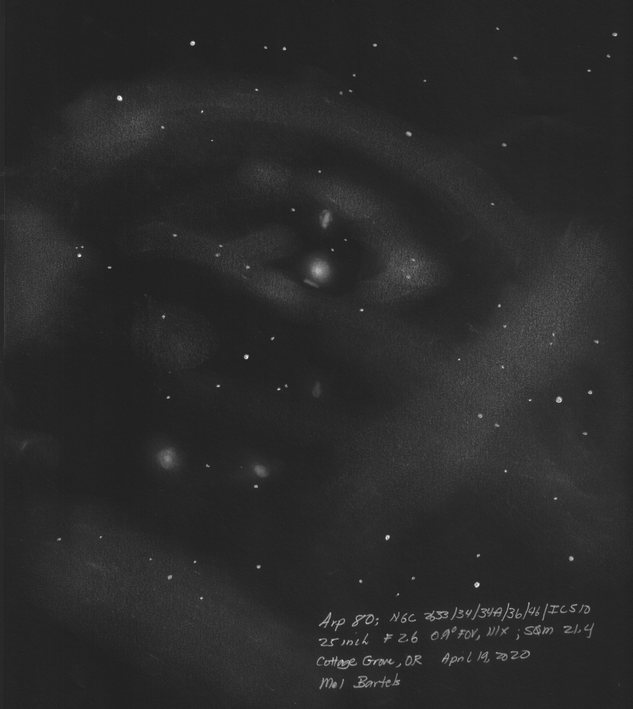
IFN next to Minazal V (Hydra)
RA 9:00 Dec 6:00
Size 1/2x2 deg
Visibility: faint
Description: One band with an outer fainter band.
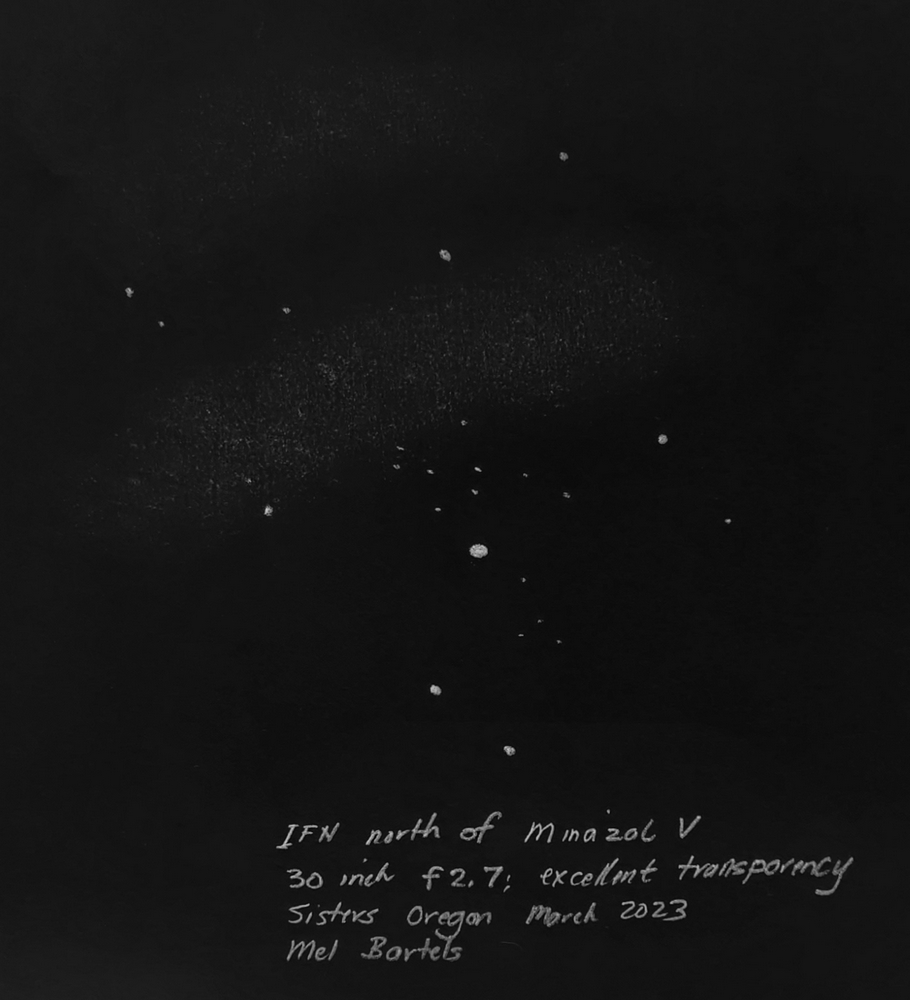
IFN next to dUMa
RA 9:00 Dec 72:00
Size 3x0.5 deg
Visibility: medium
Description: A stretched cloud of galactic cirrus northwest of dUMa. Connects to the Volcano IFN.
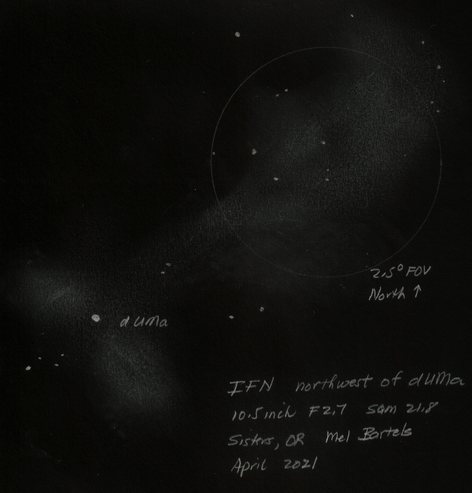
IFN next to NGC 2775
RA 9:10 Dec 7:00
Size 1/2x2 deg
Visibility: faint
Description: An arc at the edge of the field.
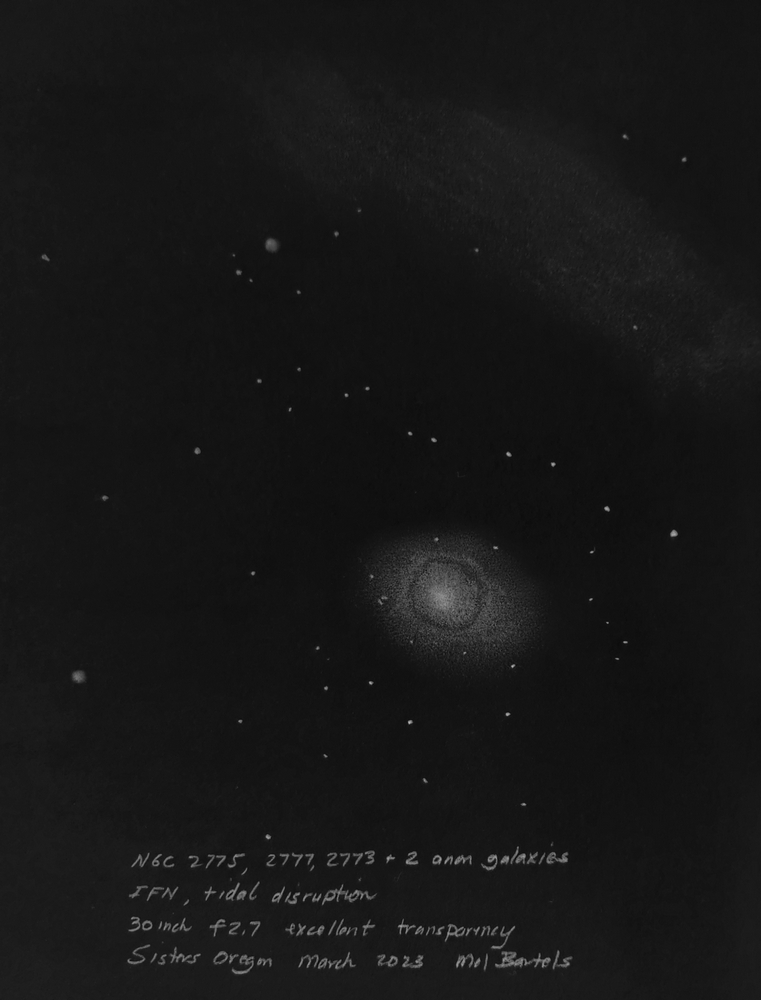
NGC 2903
RA 9:30 Dec 20:20
Size 4x5 deg
Visibility: medium
Description: pretty area of IFN with NGC 2903; IFN arc sketched looks to be two if not three separate but overlapping IFNs; begs for further investigation with larger aperture.
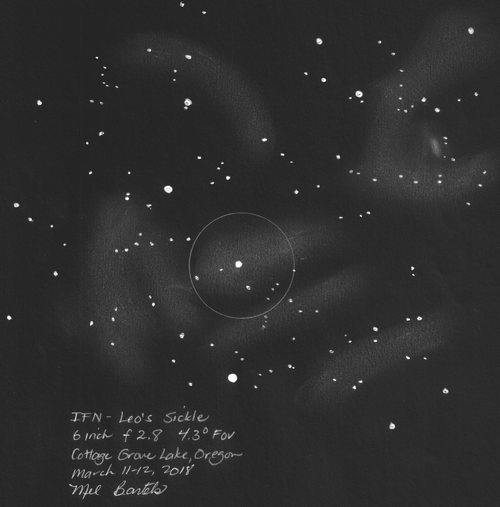
Volcano IFN
RA 9:40 Dec 70:20
Size 1x2 deg
Visibility: bright
Description: Parallel bands capped by band and blob beyond; base is broad bright area; faint extension curving to NGC 2959. Herschel region 32.

Northeast of Iota Hydrae
RA 9:45 Dec 1:00
Size 4x6 deg
Visibility: medium
Description: Beginning a degree or two to the northeast of Iota Hydrae is a relatively bright but amorphous region that streaks north/south; to the south the direction changes to more east/west, looping around forming a dark area; to the east is a slightly more pronounced darkening; a dimmer streak continues north/northwest; adjacent to the east and parallel is another faint amorphous streak; adjacent are streaks to the southwest of Regulus.
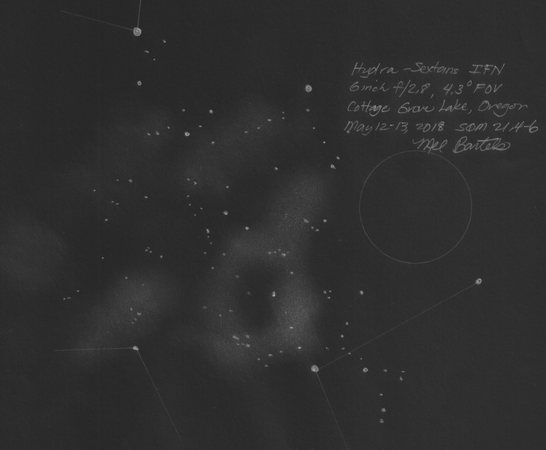
West of Regulus
RA 9:50 Dec 11:30
Size 1x5 deg
Visibility: medium
Description: arc perpendular to Milky Way west of Regulus; fainter IFN with sharper boundaries extending to south and west.

M81+M82
RA 9:55 Dec 69:20
Size 3x3 deg
Visibility: bright
Description: IFN entwined with the two galaxies; includes a side of the Volcano IFN along with the volcano's ejected puff.

M81
RA 9:55 Dec 69:00
Size 1/2x1 deg
Visibility: bright
Description: arching clouds in front of M81.
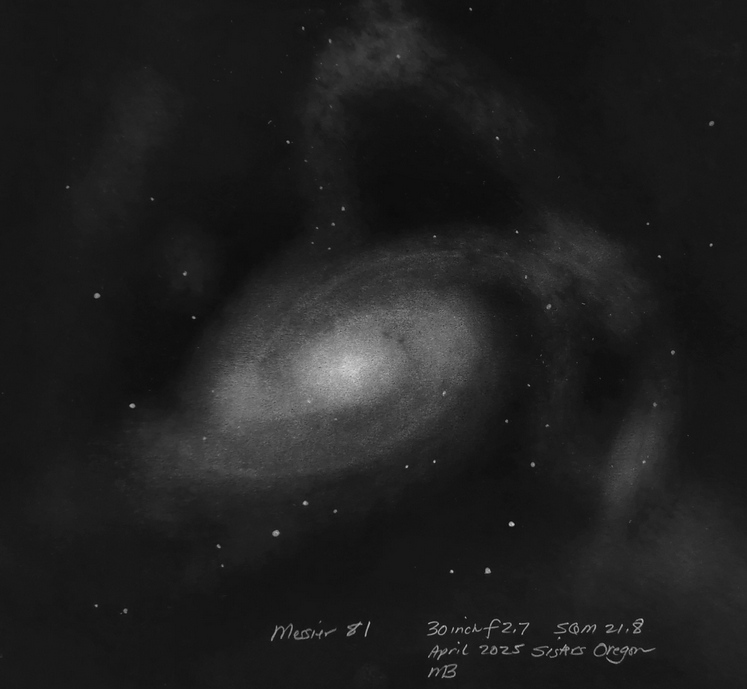
Southwest of Regulus
RA 10:00 Dec 8:20
Size 1x4 deg
Visibility: faint
Description: Two ill-defined faint bands to the southwest of Regulus..

Leo I 30 inch
RA 10:10 Dec 12:00
Size 1/2x1 deg
Visibility: faint
Description: Line of nebulosity just below Regulus; in same field as Leo I.

Leo I
RA 10:10 Dec 12:10
Size 1x3 deg
Visibility: faint
Description: encircling arc to north and east of the dwarf galaxy, Leo I. Easier to see than Leo I in smaller apertures.
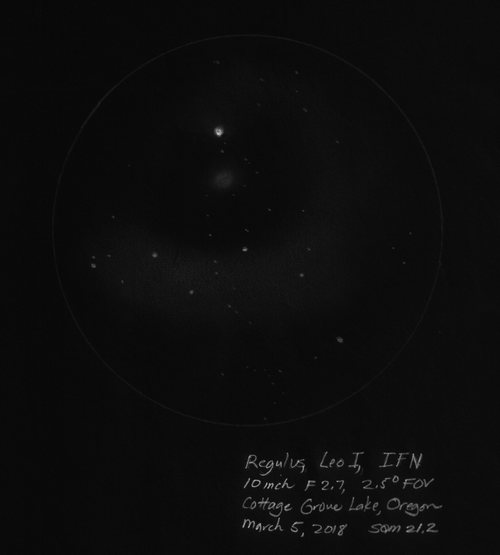
Eta Leonis
RA 10:10 Dec 16:45
Size 6x12 deg
Visibility: medium
Description: extensive region of arcs predominently to east of Eta Leonis with arcs to west of Eta and south to Regulus.

Hickson 44
RA 10:20 Dec 22:
Size 1x2 deg
Visibility: medium
Description: Two bars at right angles to the side of Hickson 44.
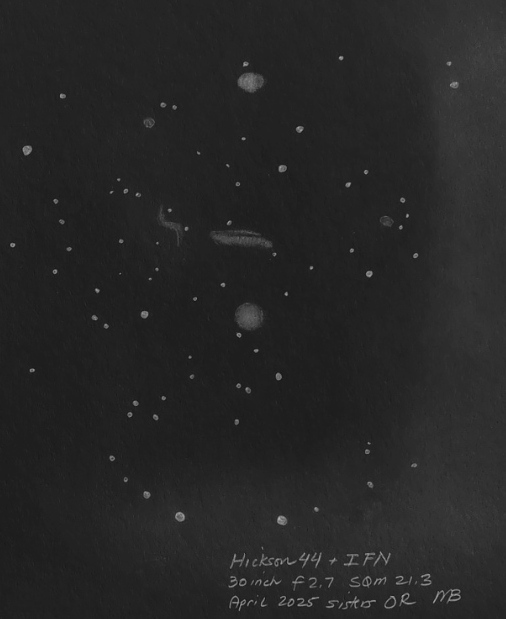
Zeta Leonis
RA 10:20 Dec 23:20
Size 1x5 deg
Visibility: medium
Description: arc extending east-west just north of Zeta Leonis.

Northern Sextans
RA 10:20 Dec 2:20
Size 1x5 deg
Visibility: faint
Description: Faint ill-defined bands that move from northwest to southeast yet as a group form a larger structure arcing from west to east/northeast: I count the bands below and above, southeast of Beta Sextantis and centered on 31 Leonis, as separate parallel bands.
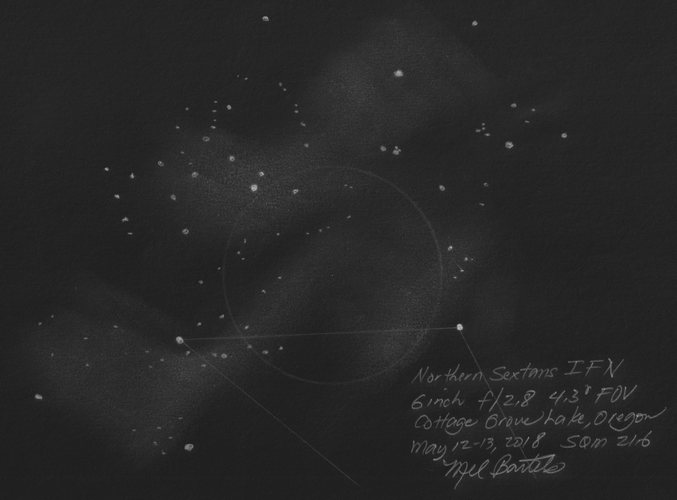
NGC 3310
RA 10:40 Dec 53:30
Size 1x5 deg
Visibility: medium
Description: several puffs that stretch out in a pretty line. Herschel’s region 34.

Angel IFN
RA 10:40 Dec 73:30
Size 1/2x2 deg
Visibility: medium
Description: Streak starting at HD90696, one of the eyes, separating into two curved portions representing the feet; extensions to sides representing wings.

NGC 3353
RA 10:45 Dec 56:00
Size 1/4x1 deg
Visibility: very faint
Description: Streaks going into and next to NGC 3353.

Leo's backbone
RA 10:45 Dec 23:00
Size 10x5 deg
Visibility: faint
Description: Cup shaped staring with mLeo base then sweeping up to 41LMi then slightly less faint and broader sweep to the E and also to the N.
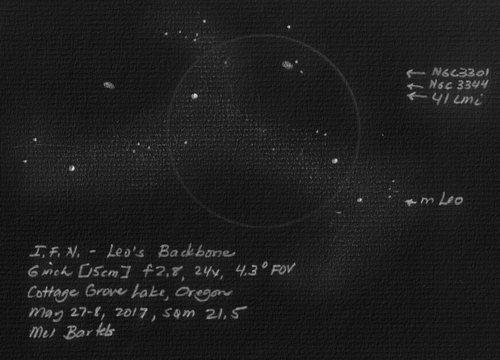
M95,96,105
RA 10:45 Dec 11:35
Size 4x12 deg
Visibility: bright
Description: M95,96 and 105 are embedded in a rich field of IFN distinguished more by the dark areas between the IFN.

Sextans to southern Leo
RA 11:00 Dec 3:00
Size 2x12 deg
Visibility: faint
Description: Continuation of a huge arc, often broken into brighter patches, starting near Iota Hydrae then stretching to the east of Denebola with a major diversion to the southeast near Phi Leonis that stretches to western Virgo.

Arp 205 NGC 3448 UGC 6016 IFN
RA 11:00 Dec 54:30
Size 1x2 deg
Visibility: faint
Description: broad arc just beyond NGC 3448; obvious at first look.
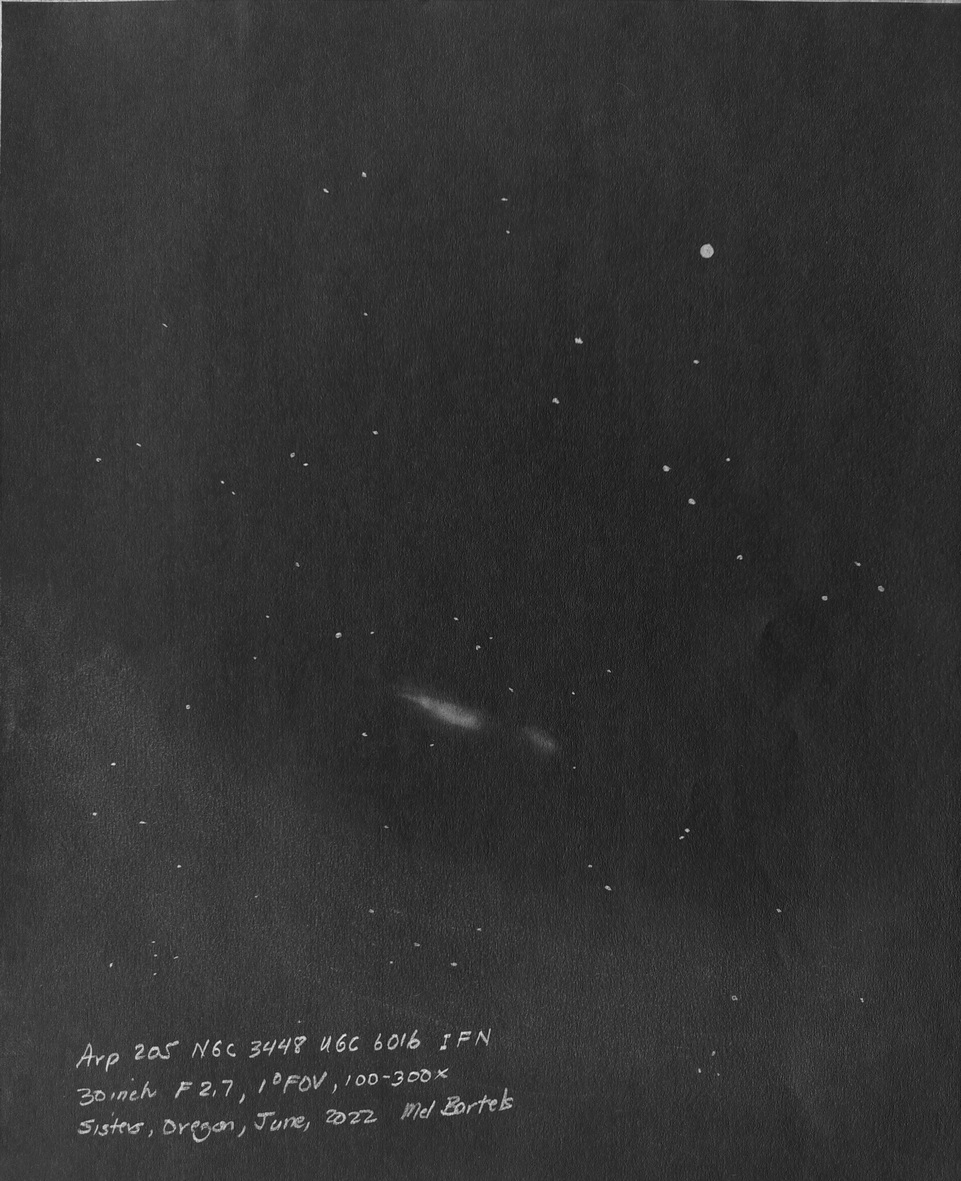
Southern Leo
RA 11:10 Dec 5:00
Size 2x10 deg
Visibility: medium
Description: A brighter portion of a huge arc stretching east/northeast across the extreme south of Leo.

Hickson 50 to M97
RA 11:15 Dec 55:00
Size 1/2x1 deg
Visibility: faint near Hickson 50, medium near M97
Description: A band that increases in brightness and fingers up to M97.
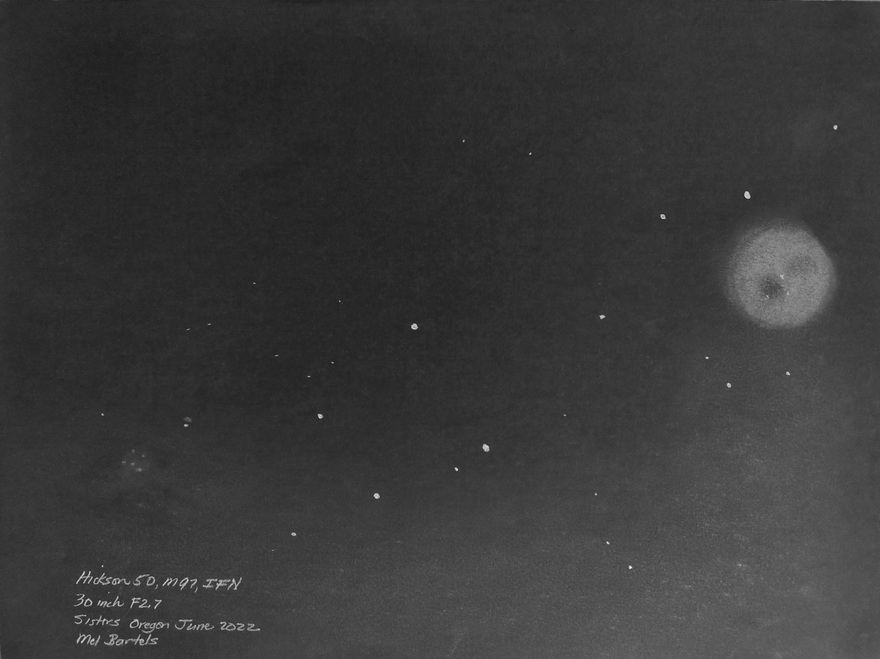
Leo Triplet
RA 11:20 Dec 13:00
Size 1x3 deg
Visibility: faint
Description: An arc that curves around the galaxy group; a very faint extension reaches to NGC 3628; part of the arc that starts next to M64, extends just north of Denebola.

SW of CO Cam
RA 11:30 Dec 73:30
Size 2x5 deg
Visibility: bright
Description: Beautiful double winged nebula that arches out from CO Cam and associated IFN then coalesces to a single large IFN near the Angle IFN.

Hickson 56, NGC 3718
RA 11:30 Dec 53:00
Size 1x2 deg
Visibility: faint
Description: Faint streak to the side of NCC 3718 and NGC 3729 that hooks between the galaxies. Could be part of a larger IFN.
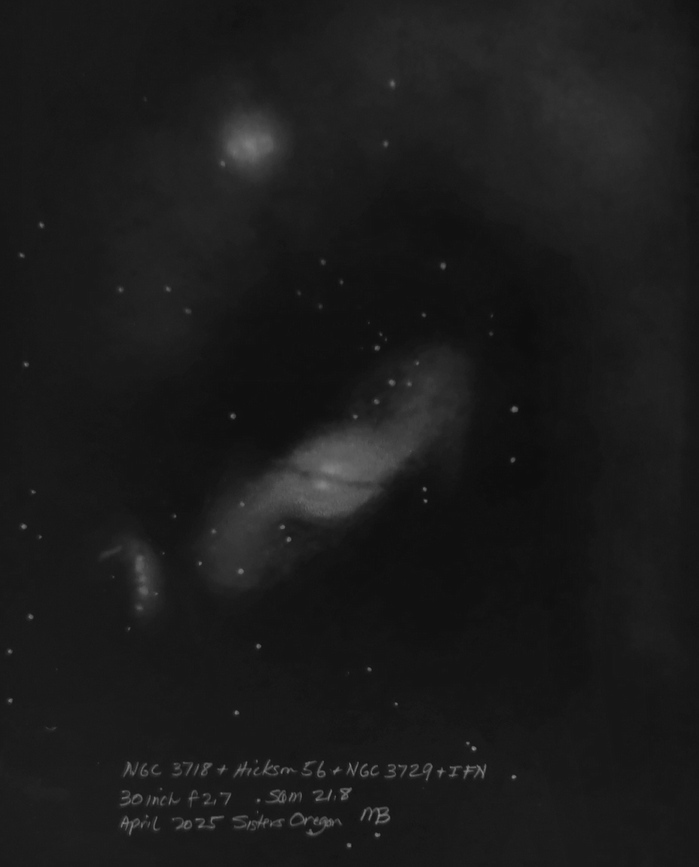
Denebola W
RA 11:30 Dec 16:10
Size 1x4 deg
Visibility: medium
Description: Fainter streak west of Denebola, extends very fainter to SW of Denebola with NE extension that meets spike that extends southward to Denebola.

Filament north of Crater
RA 11:40 Dec 7:00
Size 1x10 deg
Visibility: bright
Description: Beautiful wandering narrow filament with defined edges and good contrast north of Theta Crateris.
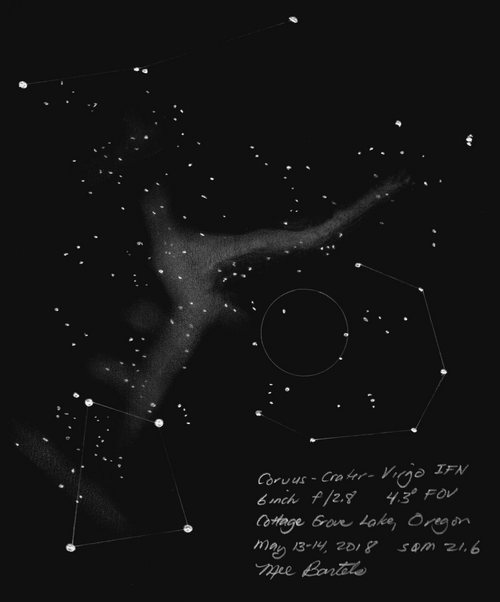
Bowl of Big Dipper
RA 11:45 Dec 48:00
Size 1x2 deg
Visibility: medium
Description: Broad zone near Al Kaphrah.

Bowl of Big Dipper
RA 11:50 Dec 60:40
Size 2x9 deg
Visibility: bright
Description: Narrower arc beginning W of Megrez that curves into elongated blob which almost touches a similar sized blob of same brightness; a fainter arc curves N of Megrez.

Denebola NE
RA 12:00 Dec 16:40
Size 2x4 deg
Visibility: medium
Description: Curved arc; faint extension to Denebola's immediate south.

M109
RA 12:00 Dec 53:20
Size 2x2 deg
Visibility: dim
Description: Broad area of brightness immediately SW of M109.
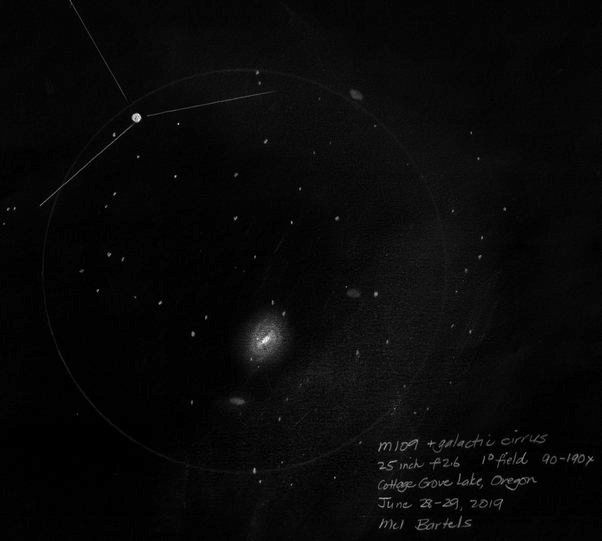
Polaris to M81-82
RA 12:00 Dec 75:00
Size 2x30 deg
Visibility: bright to faint
Description: A monstrously large detailed arc from beyond Polaris to beyond M81-82. I can sweep the length of the arc using an ultra wide small aperture telescope. This arc incorporates other smaller IFNs.

Polaris to M81-82 unaided eyes
RA 12:00 Dec 75:00
Size 2x30 deg
Visibility: extremely faint
Description: I have managed to see substantial parts of this extended IFN with binocs and more modest sections with my unaided-eyes. M81-82 are faintly visible as an extended hazy patch.

Northwest of Corvus
RA 12:10 Dec -10:00
Size 2x10 deg
Visibility: bright
Description: Large rectangular region with indistinct boundaries that curves downward towards Corvus.

CO Cam
RA 12:13 Dec 77:30
Size 2x2 deg
Visibility: bright
Description: Bright nebulosity centered on CO Cam and grouping of bright stars; areas of surrounding IFN; pretty and easy in very transparent skies. A beautiful double winged IFN stretches to the southwest for many degrees.

Melotte 111
RA 12:20 Dec 24:20
Size 3x8 deg
Visibility: faint
Description: Broad vertical streak that joines the M64 IFN as it melds into the IFN west of Markarian's Chain.
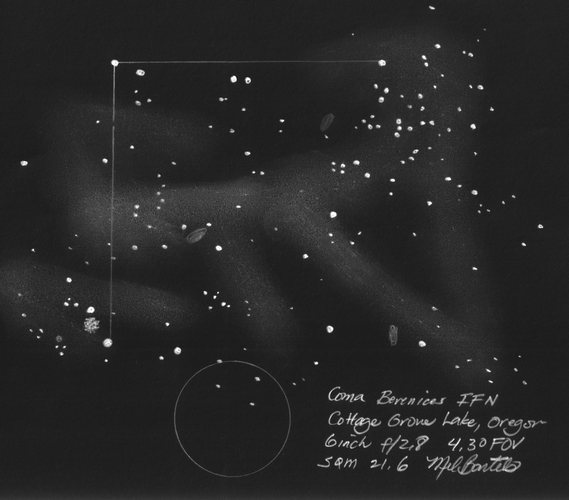
Virgo Cluster - Markarian Chain
RA 12:20 Dec 13:20
Size 2x4 deg
Visibility: faint
Description: Arc that starts N of M84 and curves to M87 then continues to heart of cluster.
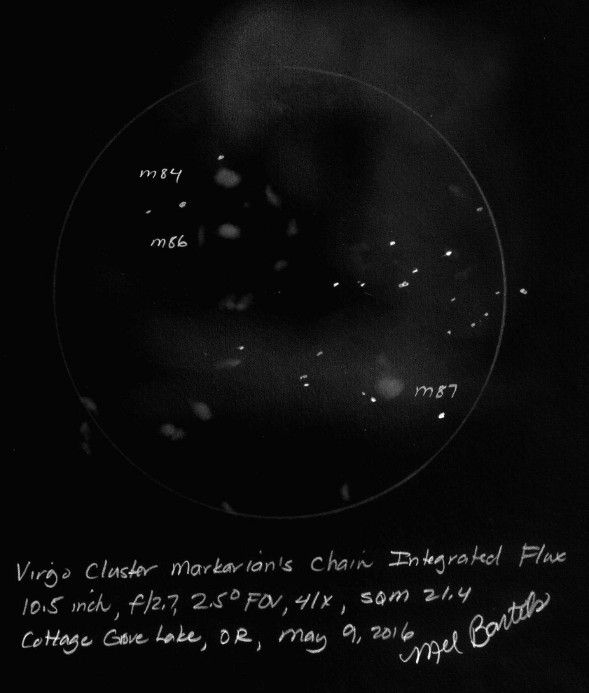
M106
RA 12:20 Dec 47:20
Size 3x2 deg
Visibility: dim
Description: Broad areas of brightness immediately SW and NE of M106.

M87
RA 12:30 Dec 12:20
Size 1x2 deg
Visibility: faint
Description: Broader streamer to east of M87 with a stream that traverses M87.
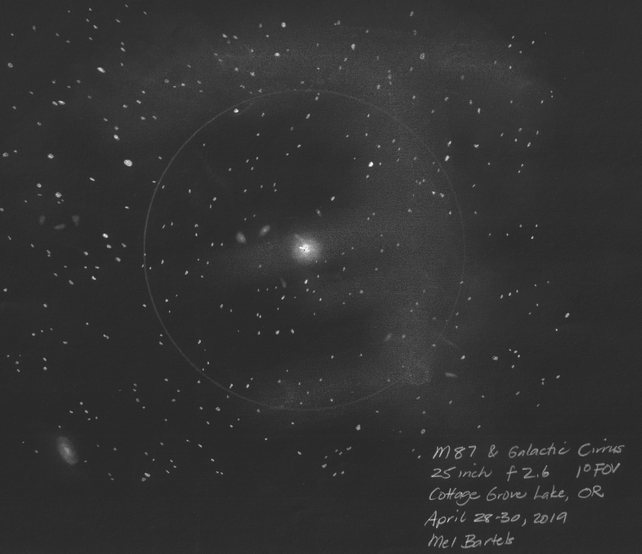
Southwest Virgo
RA 12:30 Dec -21:00
Size 1x5 deg
Visibility: faint
Description: Faint puffy IFN that dims out of view just south of Zaniah (Eta Virginis) in Virgo.

Corvus
RA 12:30 Dec -6:00
Size 1x5 deg
Visibility: faint
Description: Two streamers: the northern shorter and fainter stream crosses the top of Corvus, the bottom longer stream starts inside Corvus then heads northeast out of Corvus.

M104 halo with IFN
RA 12:40 Dec 11:45
Size 1/2x2 deg
Visibility: very faint
Description: N-S glow next to M104; merges with M104's halo.
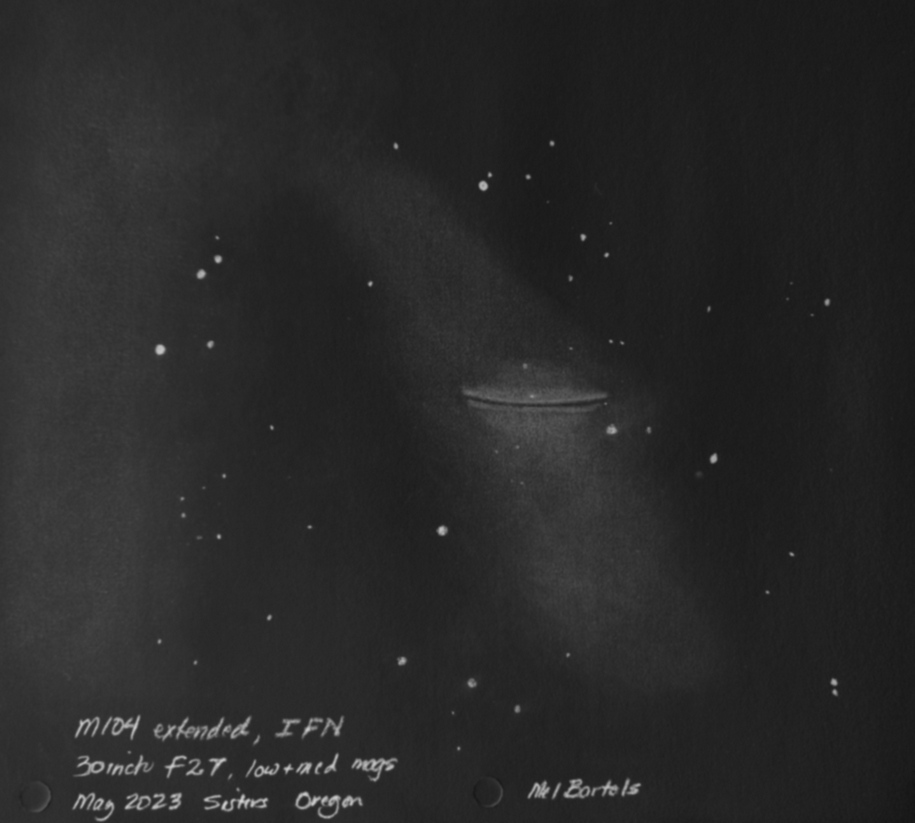
Coma Berenices
RA 12:40 Dec 22:00
Size 2x20 deg
Visibility: medium
Description: Arcs starting near M53 then sliding to the north of M64 and curving on down to the west of Markarian's Chain.

IFN near HD 110010
RA 12:40 Dec 79:05
Size 2x2 deg
Visibility: dim
Description: Streak on one side and a blob on the other of a pretty chain of stars.
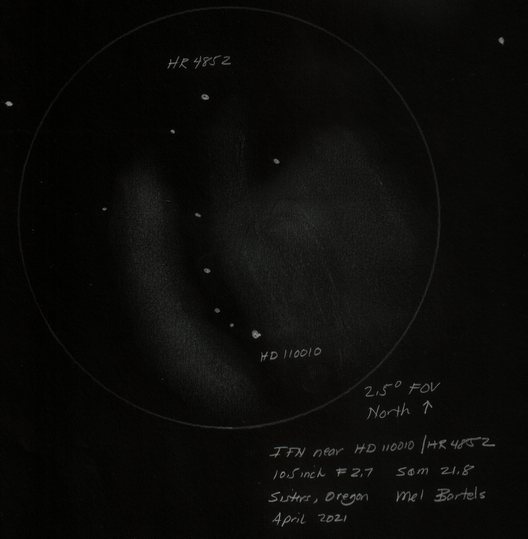
NFC 4651 + tidal streams + IFN
RA 12:45 Dec 16:00
Size 1x1 deg
Visibility: very dim
Description: Very faint IFN arc outside of the tidal stream; about equal in brightness or dimness to the tidal stream.
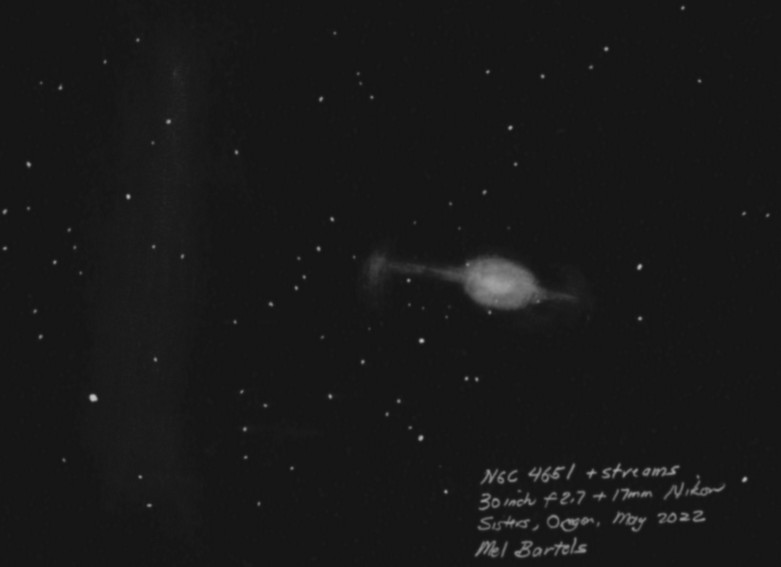
NGC 4631 double double galaxy group
RA 12:45 Dec 32:30
Size 1x1 deg
Visibility: dim
Description: Broad curved arc between the two galaxy pairs; easy to see once noticed.
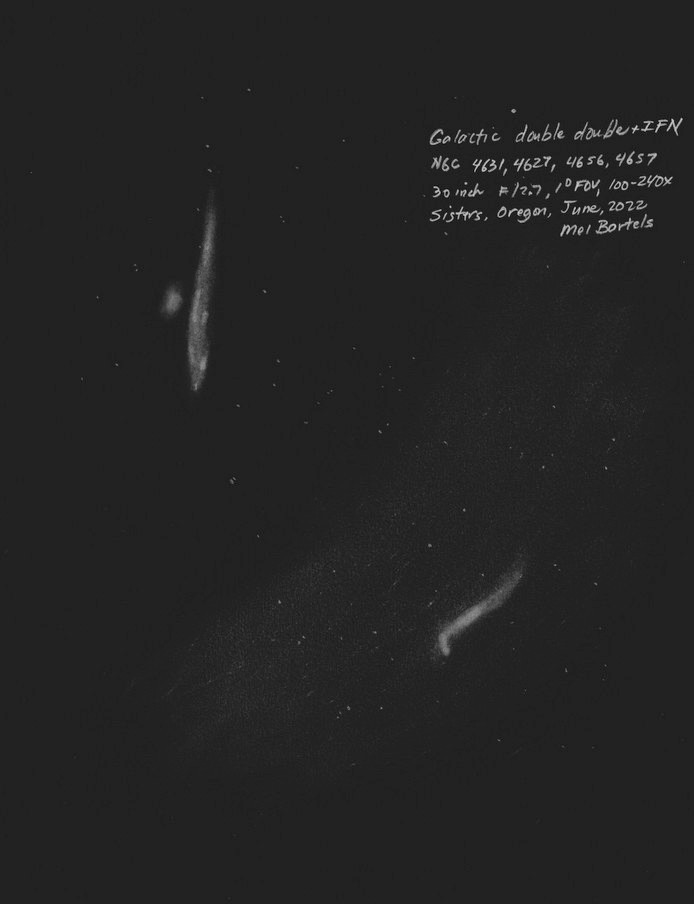
Big Dipper to Canes Venatici and back
RA 12:45 Dec 47:00
Size 15x15 deg
Visibility: dim
Description: Very large filaments that connect the Big Dipper to Canes Venatici. Most of the arc seen in 7x50 binocs.

IFN near dbl star HR 4892/3
RA 12:50 Dec 83:20
Size 2x10 deg
Visibility: bright
Description: Faint streakiness near the beautiful double star HR 4892/3 that then leads to a bright large ill-defined IFN near HR 4683.

M64
RA 13:00 Dec 21:20
Size 2x4 deg
Visibility: medium
Description: Arc that curves S to E to N of M64; fainter portion immediately W of M64.

M51 to M63 stream
RA 13:20 Dec 45:20
Size 2x8 deg
Visibility: medium
Description: East of M51 then brightest portion south of M51 with faint blob just SW of M51 sliding by NW of M63 and continuing onward.

Alcor and Mizar
RA 13:25 Dec 54:45
Size 3x3 deg
Visibility: medium
Description: Main bright area is broken into two parallel bands SW of Alcor and Mizar; extends and fades further to the W with a smaller arc N of the stars.
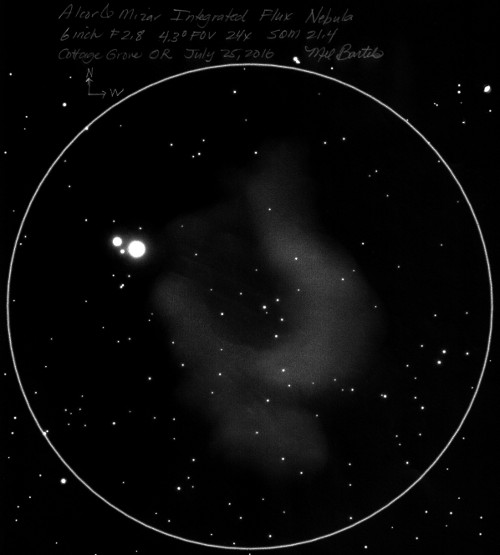
M51 IFN with companion extensions
RA 13:30 Dec 47:00
Size 1x2 deg
Visibility: medium
Description: Complex field of IFN near M51 as seen with my 13". One IFN almost connects with an extension from M51's companion. The greyness of the galaxies make a nice contrast with the white stars. Compare with the much wider field sketch stretching to M63 using my 6".

M51 IFN one degree field
RA 13:30 Dec 47:00
Size 1x1 deg
Visibility: medium
Description: Complex field of IFN near M51 as seen with my 25".

Arcturus to Coma Berenices
RA 13:40 Dec 20:00
Size 8x8 deg
Visibility: faint
Description: Faint region of blobs and arcs that connect the Coma Berenices east-west oriented IFN to the more patchy Bootes IFN; the curved hook to the south is pretty and the two quasi-parallel east-west IFN coming out of the mid Declination of Coma Berenices can be followed for a distance before turning into blobs that are difficult to tease out exact edges.
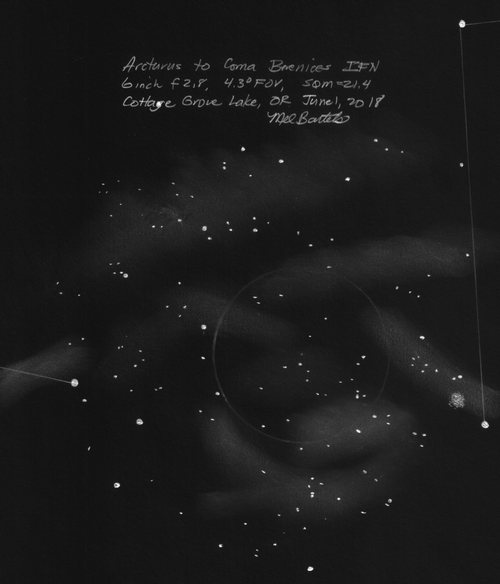
M3
RA 13:45 Dec 3:00
Size 1x1 deg
Visibility: faint
Description: A wall of IFN to the SE of M3.
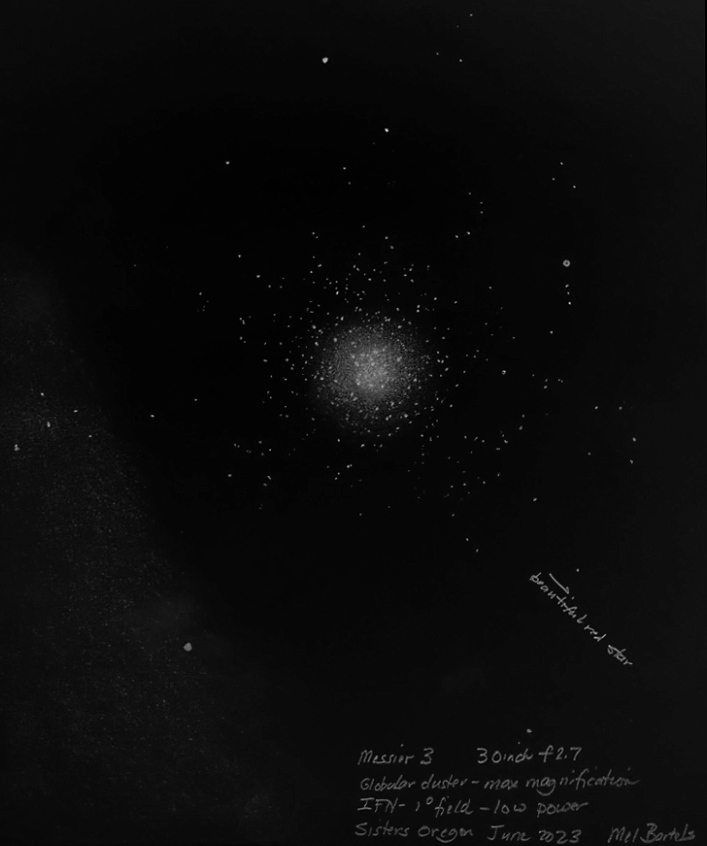
M101
RA 14:00 Dec 54:15
Size 1x2 deg
Visibility: faint
Description: Faint IFN to side of M101, seen on a night of great transparency. IFN reaches NGC 5474. M101 sits in a circular glow with embedded spiral arms.
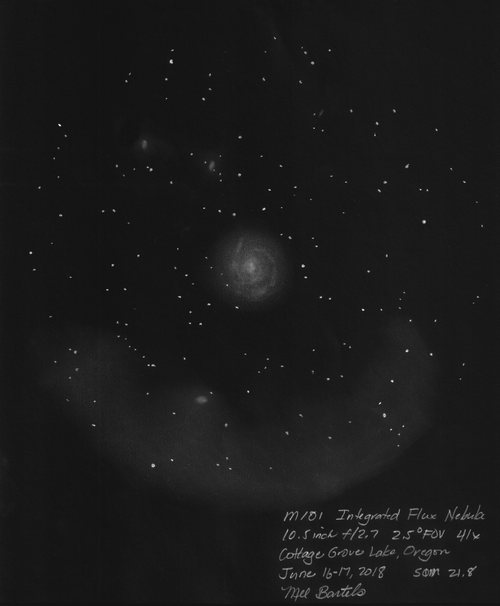
M101, 30 inch f2.7
RA 14:00 Dec 54:15
Size 1/2x1/2 deg
Visibility: very faint
Description: Very faint IFN blob between M101 and NGC 5474.

Arcturus, W of
RA 14:00 Dec 19:20
Size 2x4 deg
Visibility: medium
Description: Two areas: one immediately NW of Arcturus and a larger slightly brighter area further W of Arcturus.
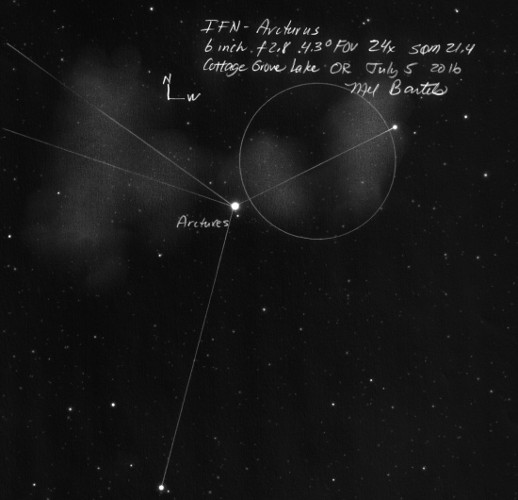
Arcturus, E of
RA 14:30 Dec 22:40
Size 1x4 deg
Visibility: medium
Description: Elongated N-S.

Northern Bootes to Ursa Major
RA 14:40 Dec 48:00
Size 2x6 deg
Visibility: bright
Description: series of bright concentrations, often elongated, with smooth boundaries between i Bootis and Alkaid. The concentration near 38 Bootis is quite bright, though large and ill defined because the field brightens ever so gradually. Most of the streaks appear to be oriented SW to NE.
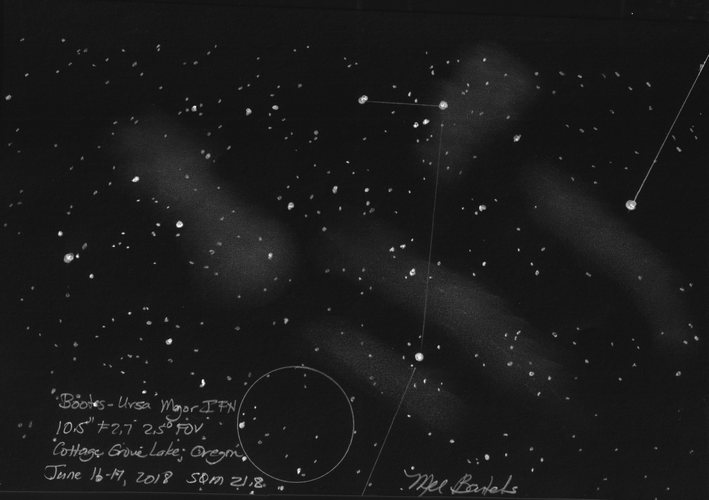
Serpens Caput to Virgo streamer
RA 15:00 Dec -04:00
Size 2x40 deg
Visibility: bright
Description: Astonishing linear feature that stretches from Mu Serpenis in Serpens Caput to Zeta Virginis, Heze in Virgo with a spur NW of Libra; background dims NW of Libra making the linear feature easily distinguishable from the background.
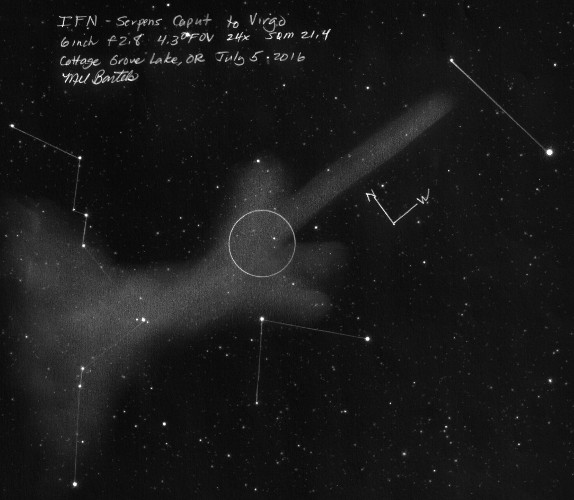
Ursa Minor Dwarf Galaxy IFN
RA 15:10 Dec 67:00
Size 1x1 deg
Visibility: medium
Description: Broad area with defined edge next to sweep of stars; of roughly equal brightness to the Ursa Minor Dwarf Galaxy but with impression of different hue.
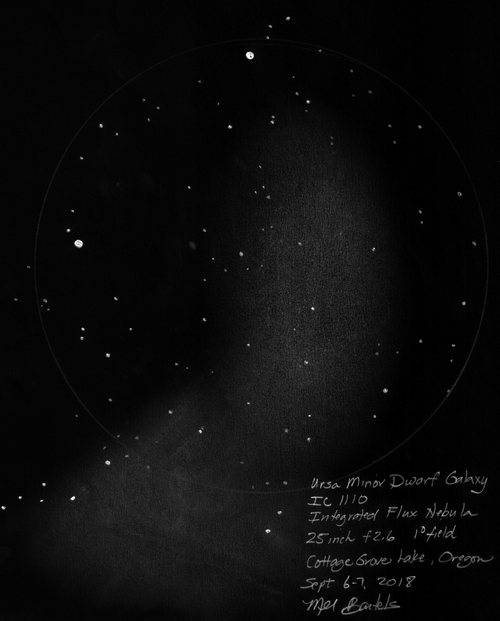
Bootes, N of
RA 15:10 Dec 46:00
Size 2x8 deg
Visibility: medium
Description: Broad arc N of Beta Bootis, Nekkar; may connect to M51/M64 arc.
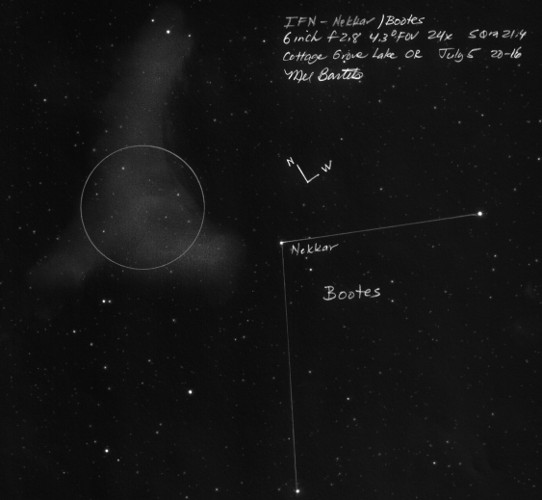
NGC5907
RA 15:15 Dec 56:00
Size 1x2 deg
Visibility: medium
Description: wall of IFN with a finger extension to near NGC5907; faint tidal streams of NGC5907.
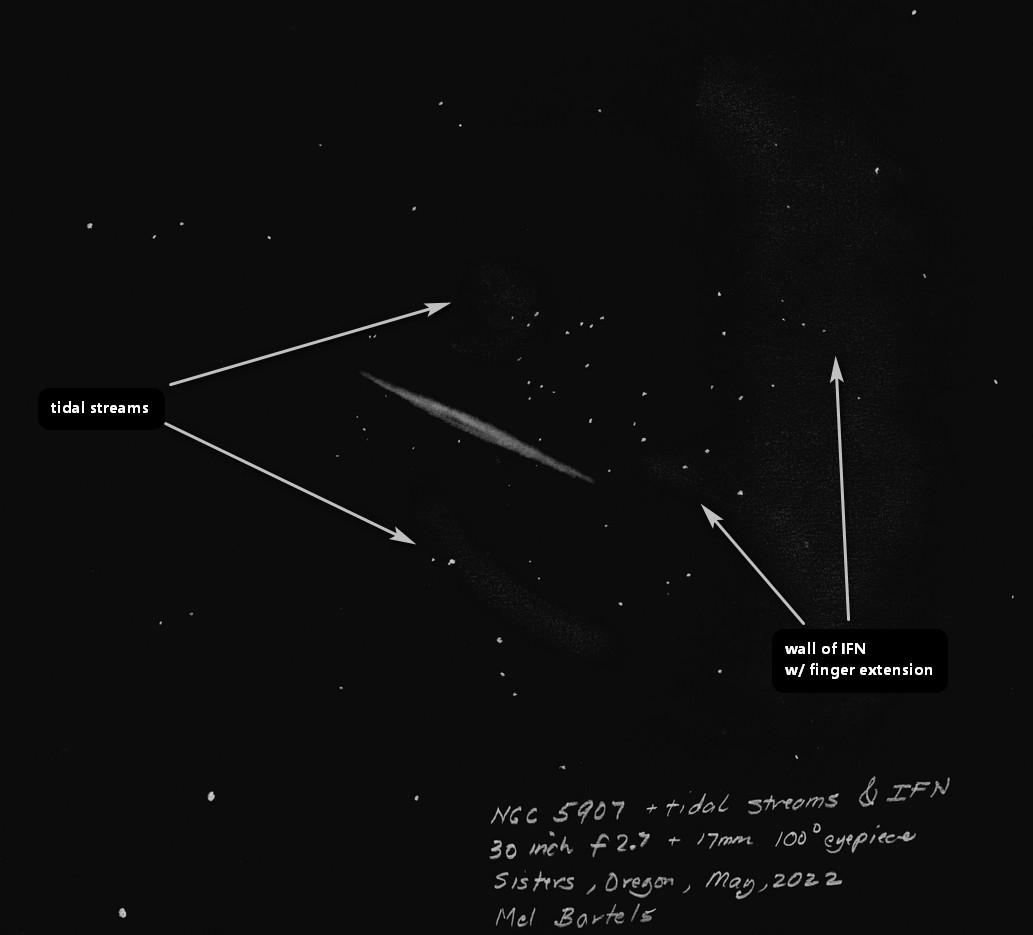
Serpens Caput to NE
RA 16:10 Dec 21:30
Size 4x4 deg
Visibility: medium
Description: Part of long arc south of keystone leading to arc NE of Serpens Caput.
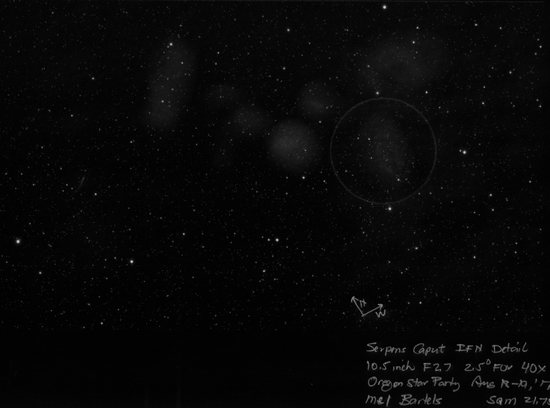
Between Corona Borealis and Serpens Caput
RA 15:20 Dec 19:00
Size 2x2 deg
Visibility: medium
Description: Floating blobs.
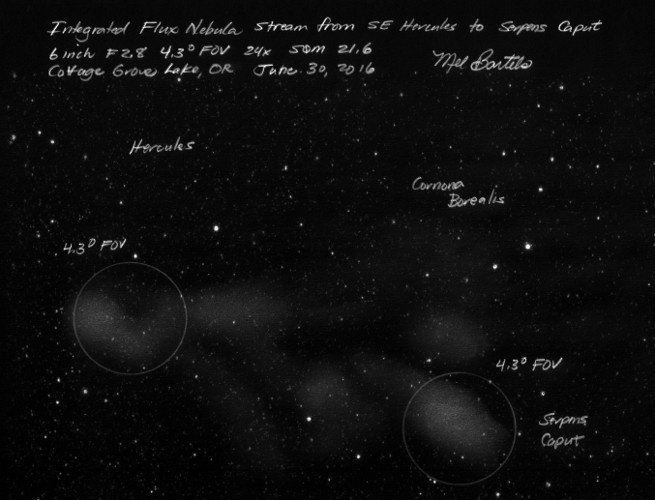
M5
RA 15:20 Dec 2:00
Size 1x2 deg
Visibility: medium
Description: Arc about Messier 5.
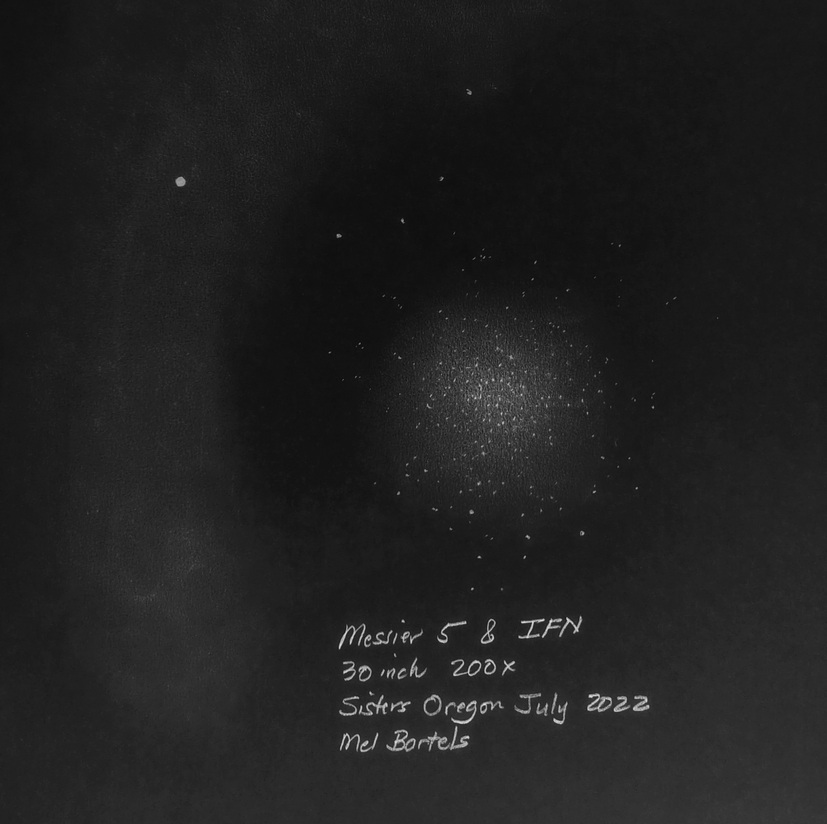
Draco Triplet
RA 15:40 Dec 59:00
Size 1x2 deg
Visibility: bright
Description: Beautiful strains of IFN with the dramatic Draco Triplet of galaxies.
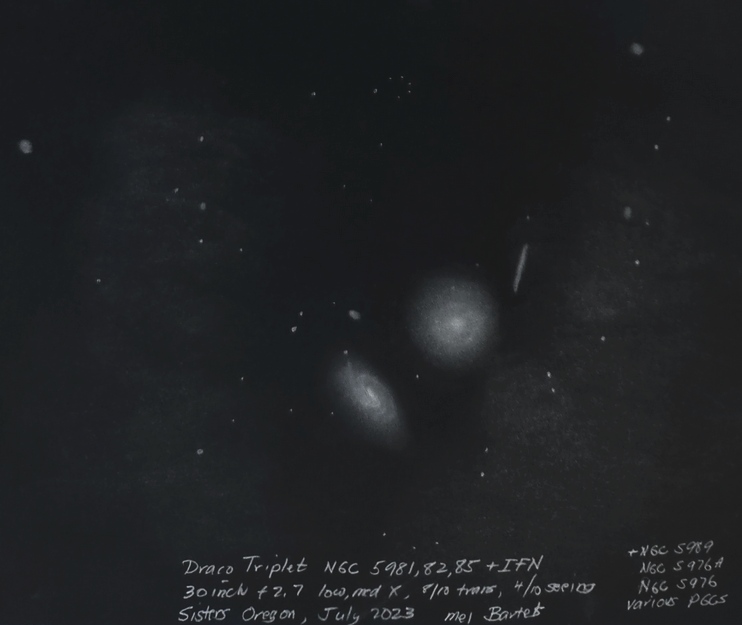
NGC5987
RA 15:40 Dec 58:00
Size 1/2x2 deg
Visibility: bright
Description: Beautiful bright IFN with sharply defined edge next to the spiral galaxy NGC 5987.

Serpens Caput detail
RA 16:00 Dec 17:30
Size 3x8 deg
Visibility: medium
Description: Using the 10.5 inch under very transparent skies I was able to see detail in the IFN in the Serpens Caput region. Here the IFN are blobby areas of differing sizes.

Abell 39
RA 16:30 Dec 28
Size 1x1 deg
Visibility: dim
Description: Wall of IFN reaching out to the planetary nebula Abell 39.
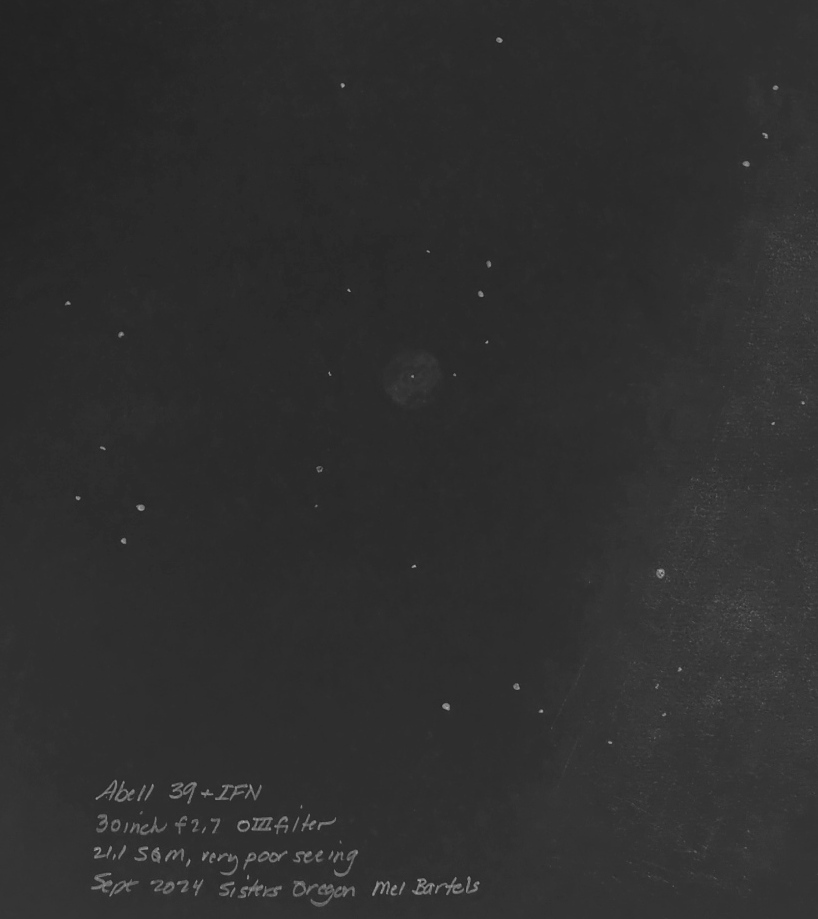
M13
RA 16:40 Dec 36:30
Size 3x3 deg
Visibility: bright
Description: M13 is embedded in a number of IFN.
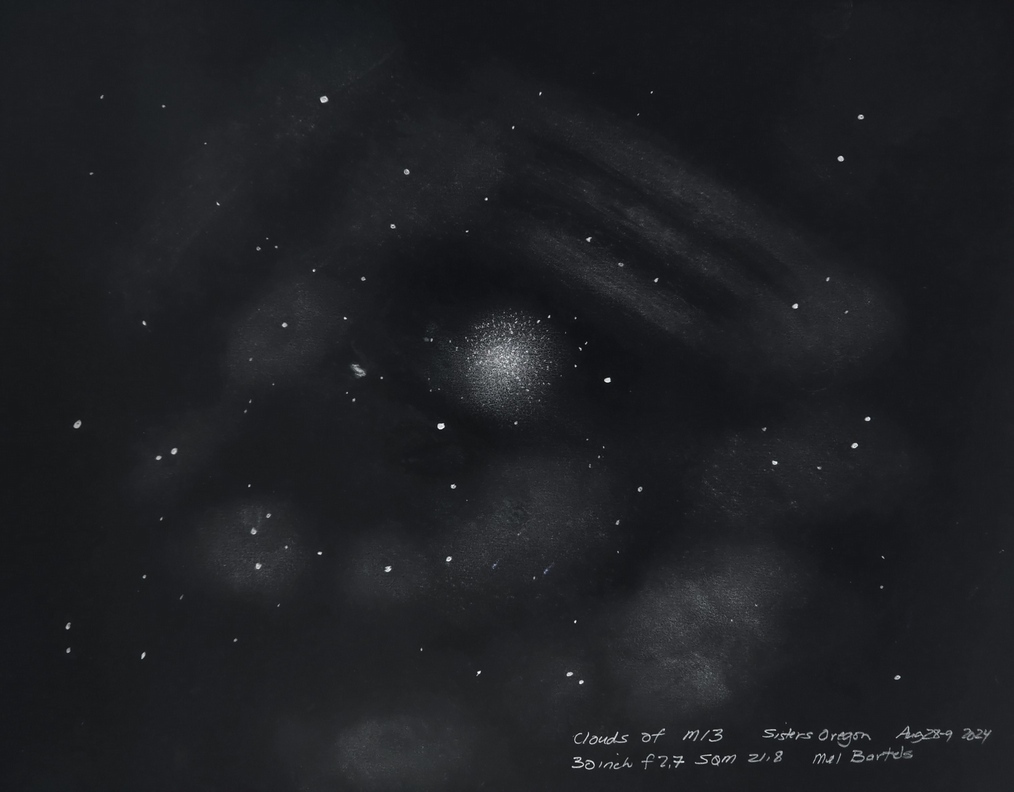
M13 IFN one degree field
RA 16:40 Dec 36:30
Size 1x2 deg
Visibility: medium
Description: Curved arc in field of view along with NGC6207 and IC4617.
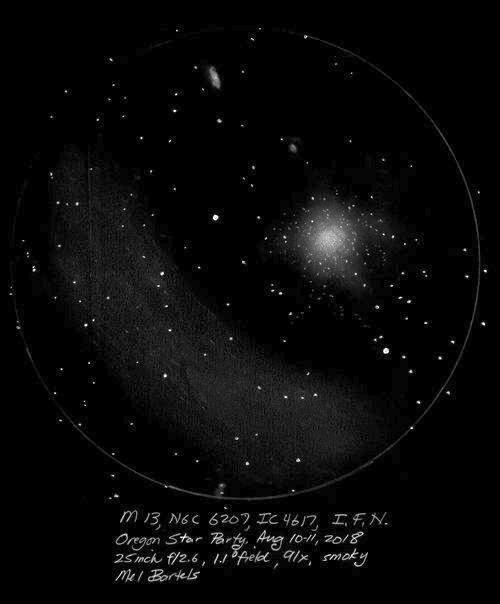
Hercules Keystone western side centered on M13
RA 16:40 Dec 36:30
Size 10x6 deg
Visibility: faint to medium
Description: Brightest patch to M13's immediate NW; next brighest is broad arc curving around Eta Herculis, the star in the NW corner of the keystone; smaller arcs extend on both sides of M13 with a broad area heading SE to Epsilon Herculis in the SE corner of the keystone.

NGC 6210
RA 16:45 Dec 23:45
Size 4x4 deg
Visibility: faint
Description: Streaks of broad nebulosity on the east side of NGC 6210, a fainter band further away on the west side. The insert shows a high power image of NGC 6210, which is quite bright and also quite small.
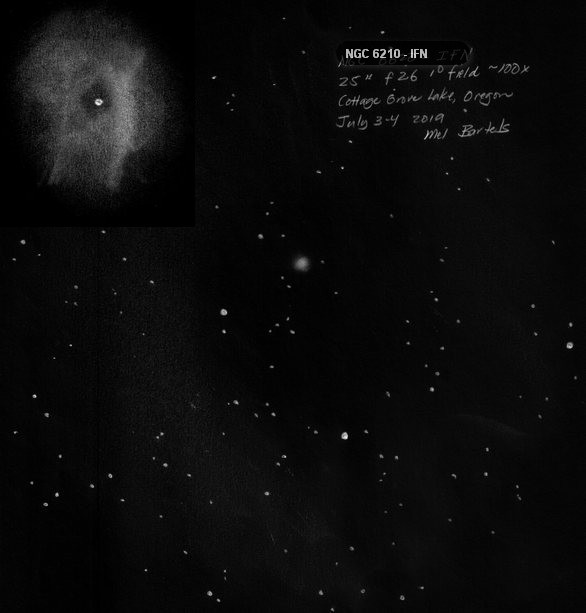
Eta Draconis
RA 16:45 Dec 60:45
Size 4x4 deg
Visibility: high
Description: Prominent angle, fainter square; interesting.
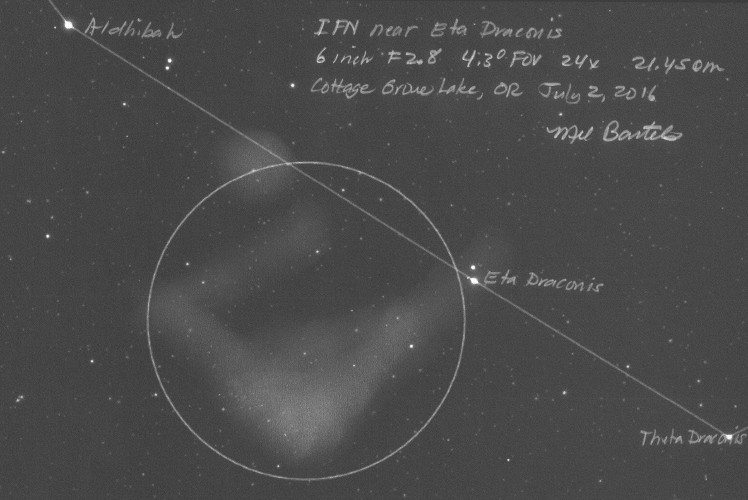
South of Hercule's keystone
RA 16:55 Dec 27:00
Size 3x15 deg
Visibility: medium
Description: Large broad sweep of IFN from east to west with branches.
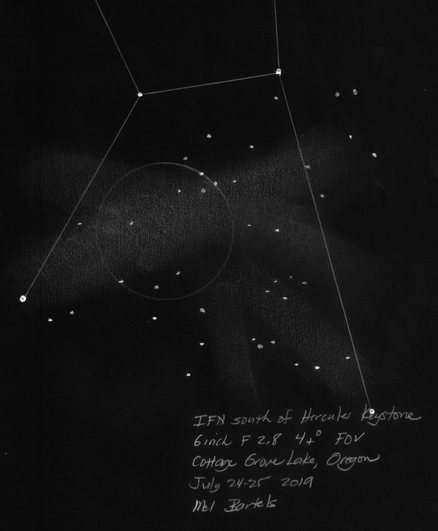
Draco's head to west
RA 17:00 Dec 53:10
Size 1/2x5 deg
Visibility: bright
Description: Head with tail that fans outward.
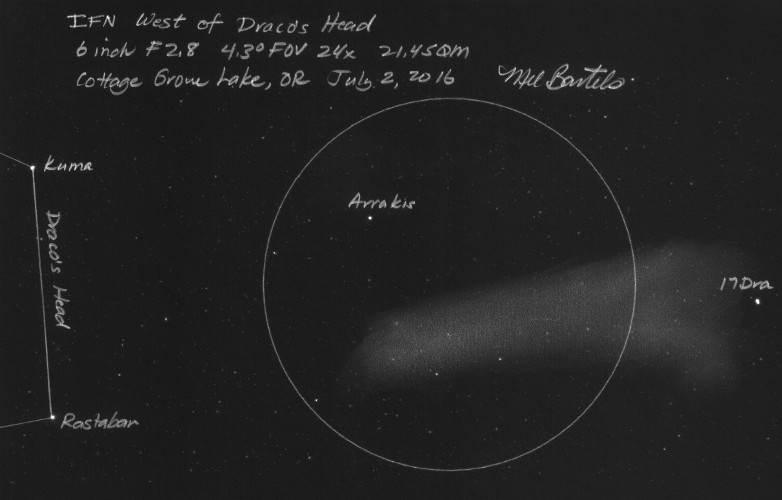
Hercules keystone to SE and S
RA 17:10 Dec 27:40
Size 2x10 deg
Visibility: medium
Description: Part of long arc south of keystone leading to arc NE of Serpens Caput; towards SW side of keystone splits into NW (leads into Corona Borealis) and SW arcs.

Draco Dwarf Galaxy
RA 17:10 Dec 58:40
Size 1/4x3 deg
Visibility: faint
Description: Arc south and west of the galaxy; western portion expands to blob.
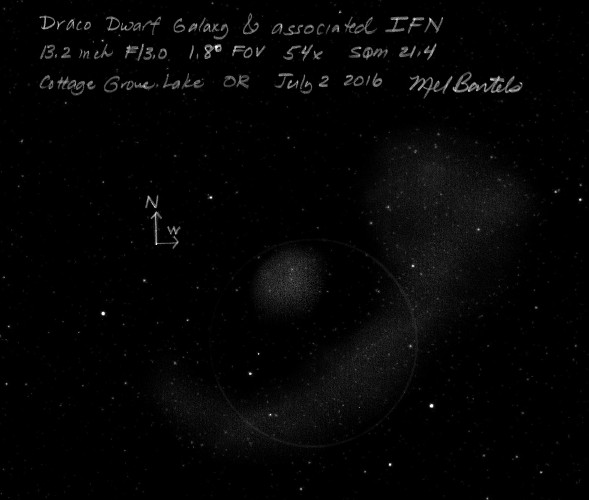
NE of M92
RA 17:10 Dec 46:15
Size 4x4 deg
Visibility: faint
Description: S of M92 is broad bright region; arc extends from N side of M92 NE to broad faint patch with dark nebula; this patch extends N to brighter broadly curved arc of 10+ degrees length.
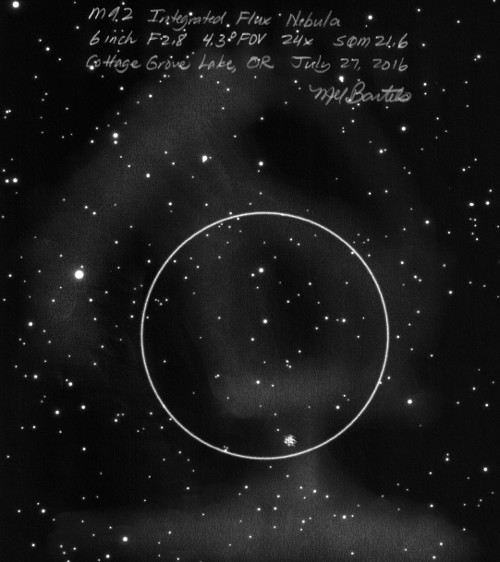
Alpha Herculis
RA 17:15 Dec 14:25
Size 4x8 deg
Visibility: bright
Description: Complex area with bright general background of galactic cirrus; bright blob 1x1 deg NE, arc 4 deg N, extensions on both sides of star leading to brighter region SW; dark arc highlights eastern edge of east most N-S arc, two more dark regions, one just N.
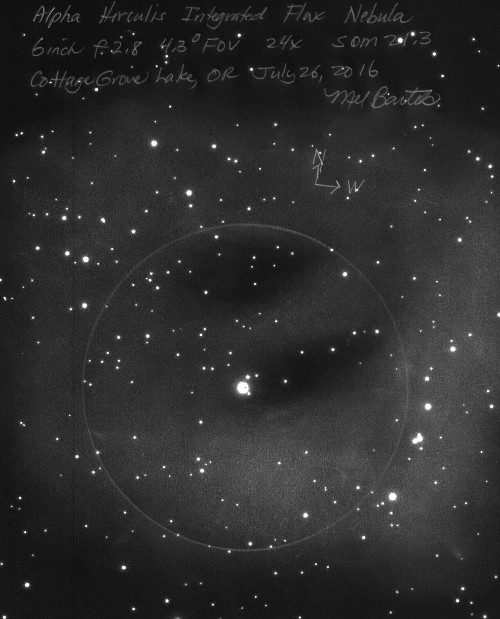
Arp 102
RA 17:20 Dec 49
Size 1/4x1 deg
Visibility: very faint
Description: two parallel streamers, one goes through the bright double star to the east of Arp 102, the other goes through Arp 102; making it harder to see the galactic tidal streams.
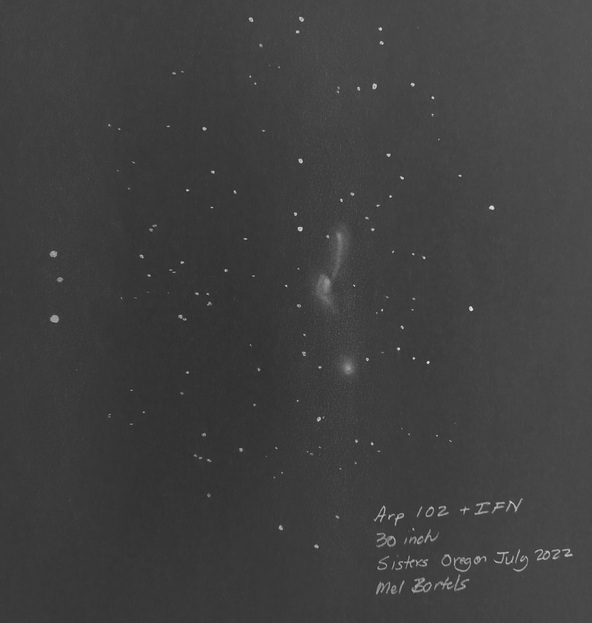
Kappa Lyrae to Theta Herculis
RA 18:10 Dec 36:00
Size 5x6 deg
Visibility: faint
Description: Immediately noticeable on very transparent night is the band NE of Theta Herculis that slants down to the SE, then bends back; Theta Herculis a nice orange 'K' star as is the slightly dimmer Kappa Lyrae ; next visible is the broad arc surrounding Kappa Lyrae to the E; finally the broad finger of nebulosity that goes through a small cluster of stars in the middle of the field, joining a fainter broader arc to the S; also a broad broken stretched path to the N; all in all a pretty sight on a very transparent night; heading S to increasingly brighter portions of the Milky Way and denser star formations a wonderful experience - the Milky Way is incredibly bright in comparison.

Vega
RA 18:20 Dec 42:00
Size 2x6 deg
Visibility: bright
Description: Y' shaped with one leg leading from just NW of Vega to a large N-S elongated blob that stretches into NW Hercules.
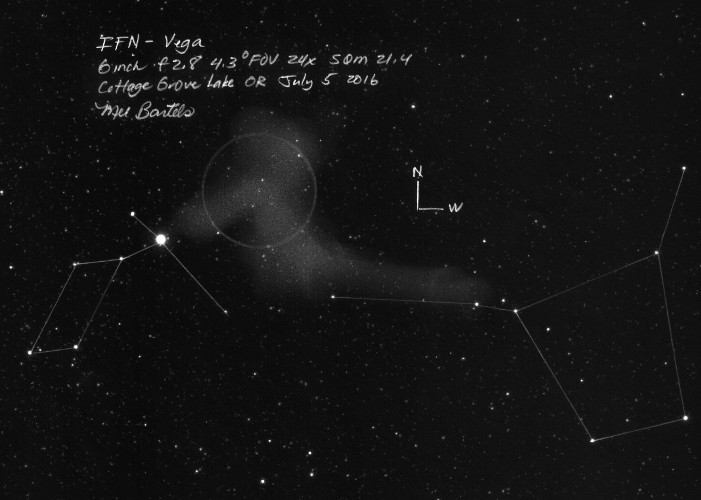
Epsilon Lyrae
RA 18:45 Dec 39:00
Size 2x3 deg
Visibility: bright
Description: Arc extending from Vega to Epsilon Lyrae with a large blob S of the double-double; bright star field.
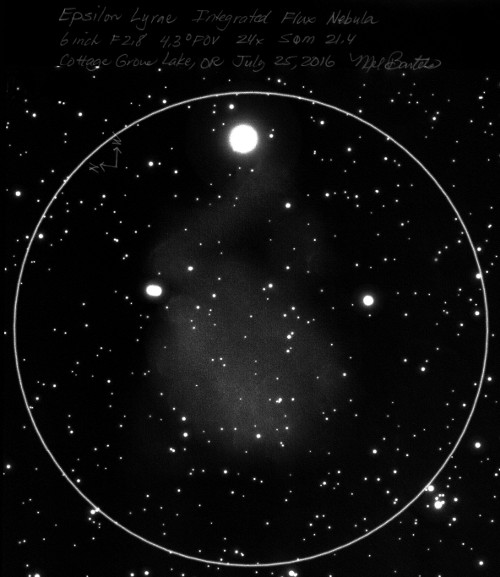
M57
RA 18:55 Dec 33:00
Size 4x4 deg
Visibility: faint
Description: Half circle somewhat centered on M57, changing to striations above.
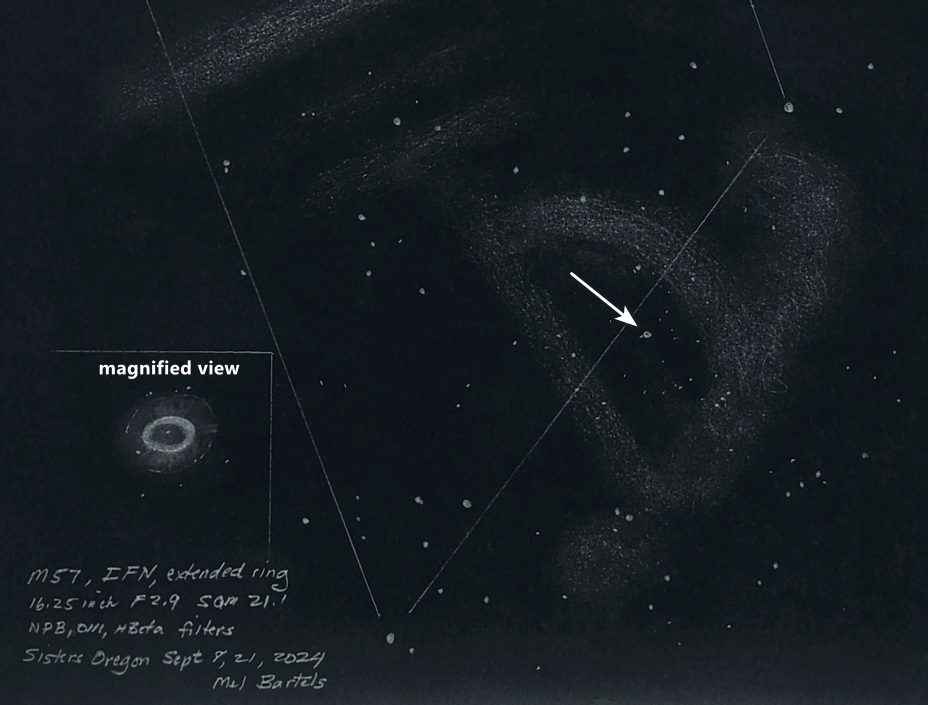
Barnard's Galaxy NGC 6822
RA 19:45 Dec -14:45
Size 3x4 deg
Visibility: bright
Description: Beautiful gossamer striations; broad S of the galaxy, thinner one that covers the galaxy and a thinner ones N.
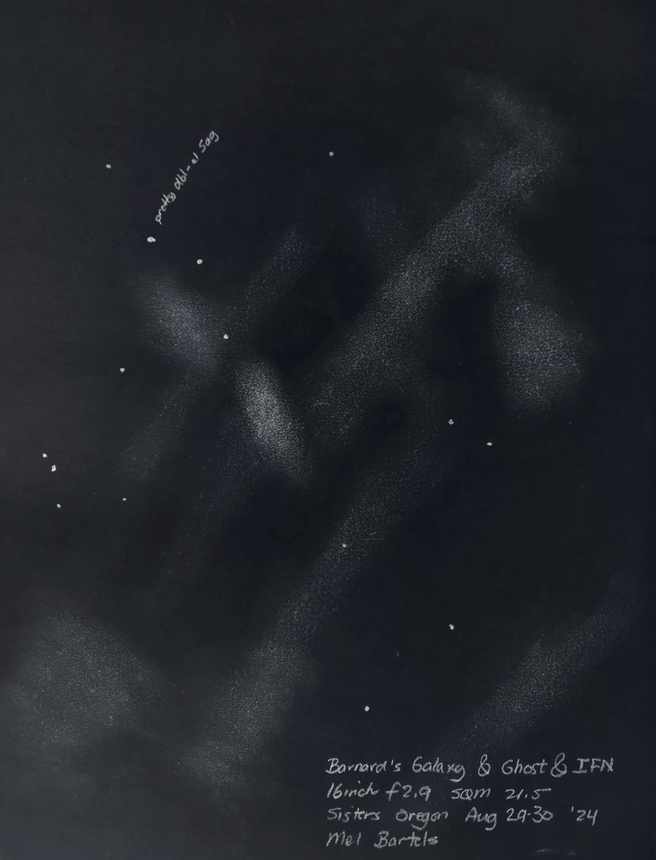
Barnard Galaxy 'The Dagger'
RA 19:45 Dec -14:45
Size 3x4 deg
Visibility: bright
Description: Through the 10.5 inch I was able to see a bright 'dagger' pointing in the direction of Barnard's Galaxy. It broadened at the far end and was enveloped in the striations that cross the field. Contrast that with the 6 inch view where the dagger and parallel band appear as a faint band with a brightening at right angle at the edge of the field. A good simulation can be obtained by squinting until the dagger almost disappears.
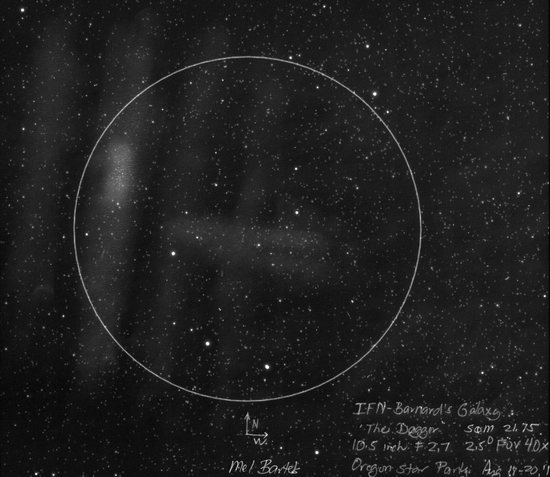
Corona Australis - NGC 6723
RA 19:00 Dec -37:20
Size 1x4 deg
Visibility: bright
Description: Long streak tapering to W, spreading out to E.
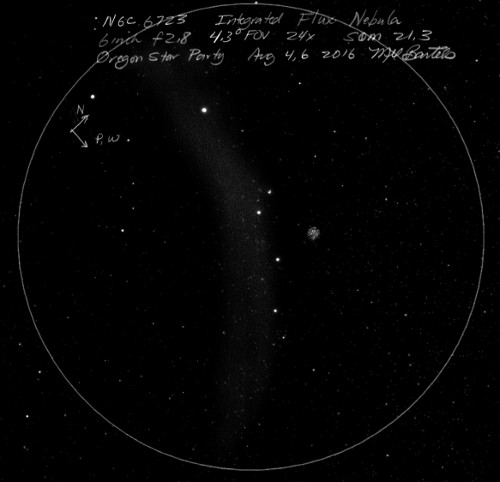
M27
RA 20:00 Dec 23:00
Size 1/2x1 deg
Visibility: bright
Description: Very close to the Milky Way, but such a distinct area of brightening centered on 14 Vul that I am including it in this catalog.

M75
RA 20:10 Dec -22:00
Size 4x4 deg
Visibility: medium
Description: Nice streamers throughout region; brightest portion is the band at right angles - perhaps not directly associated with the streamers.

Alpha Capricorni
RA 20:20 Dec -12:30
Size 4x4 deg
Visibility: faint
Description: Beautiful star field with bands in various directions of varying brightness.
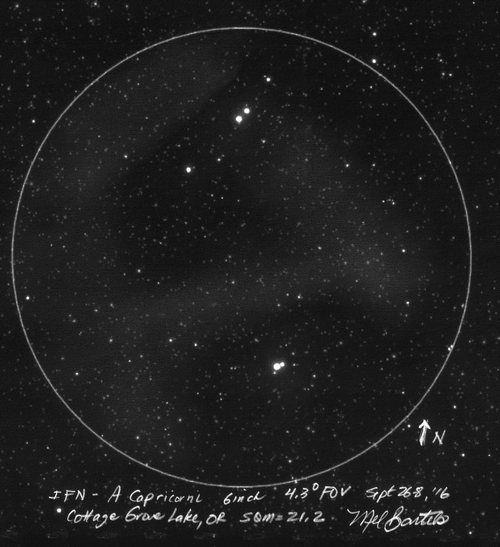
NGC 6894
RA 20:20 Dec 30:30
Size 1/4x1/2 deg
Visibility: medium
Description: Nice association of IFN with a small planetary nebula; the IFN is composed of two streaks in parallel.
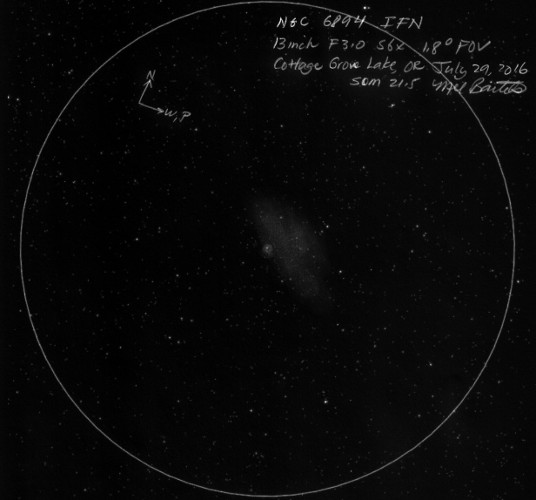
Rho Capricorni
RA 20:30 Dec -17:50
Size 1x2 deg
Visibility: faint
Description: Band with somewhat diffuse edge that stops short of star.

Fireworks Galaxy NGC 6946
RA 20:35 Dec 60:10
Size 2x2 deg
Visibility: bright
Description: Bright IFN (could be ISM this close to the Milky Way) involved with the Fireworks Galaxy NGC 6946 and the open cluster NGC 6939. The streamer coming off of the galaxy is bright, striking in its narrow definition while the other IFN areas are broader in stroke.
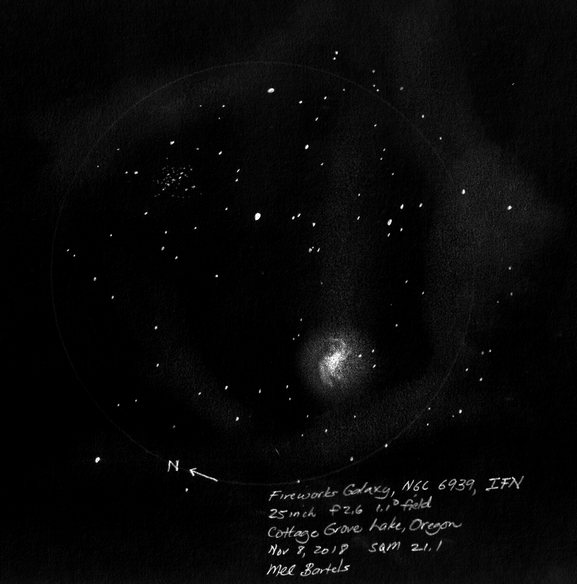
NGC 6951
RA 20:40 Dec 66:10
Size 1/2x1 deg
Visibility: medium
Description: Nice ghostly IFN pairing with a face on barred spiral; IFN in three distinct sections with a brighter much larger area to the W.
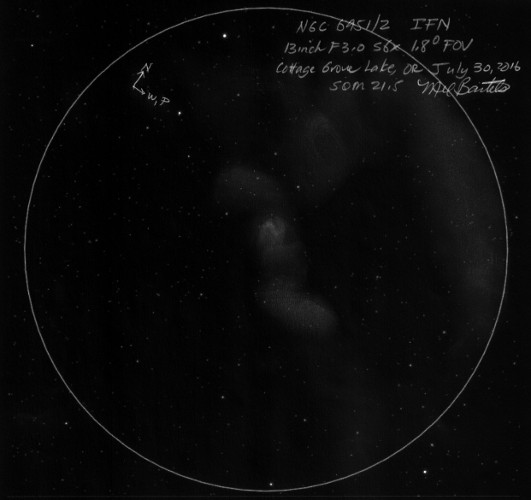
Aquarius Dwarf Galaxy
RA 20:45 Dec -13:00
Size 1/2x1 deg
Visibility: medium for IFN, difficult for the galaxy
Description: V shaped nebulosity noticeable after a few moments. Brighter than the dwarf galaxy at high etendue / low power.
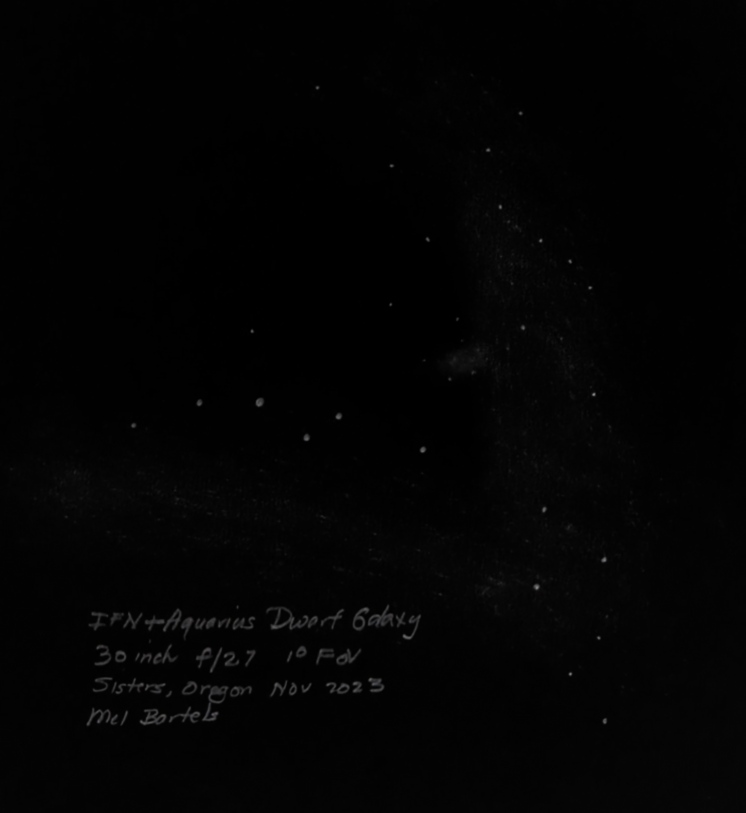
Iris Nebula
RA 21:00 Dec 61:10
Size 1x2 deg
Visibility: bright
Description: The IFN or ISM (InterStellar Medium) extends S of the nebula proper.
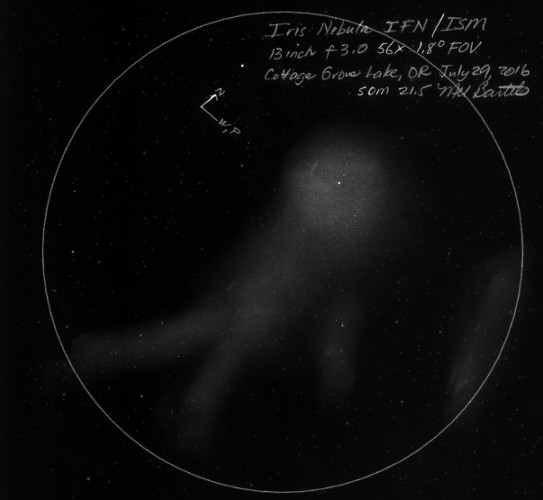
M15
RA 21:30 Dec 12:15
Size 1/2x2 deg
Visibility: faint
Description: Faint arc to W of M15.
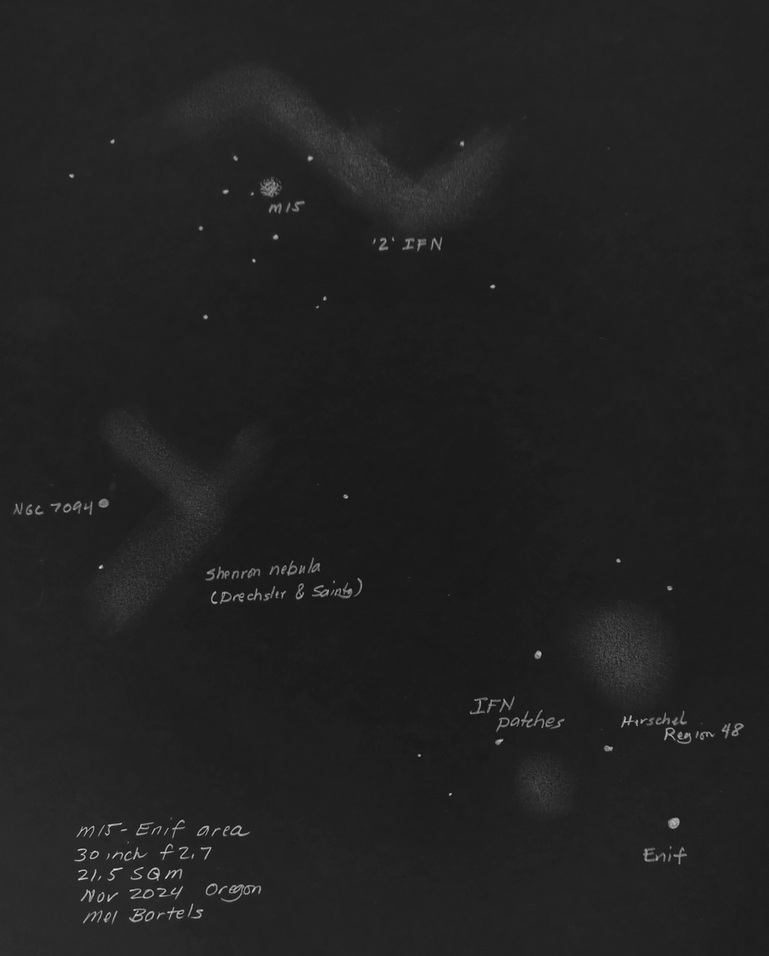
M2
RA 21:30 Dec -1:00
Size 1x2 deg
Visibility: medium
Description: M2 bright and beautifully resolved; broad streamer with band just out of field that has a fainter component that stretches through M2 with a faint band that reverses direction back towards the south. Herschel region 42.
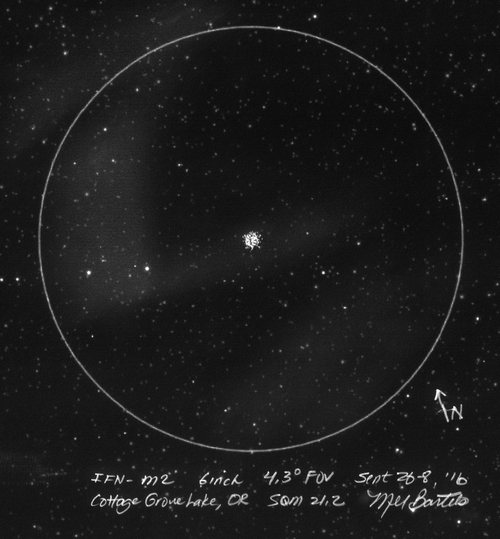
Beta Aquarii
RA 21:30 Dec -5:30
Size 4x4 deg
Visibility: medium
Description: Beautiful bright orange star with nice striations with darkest lane next to star.
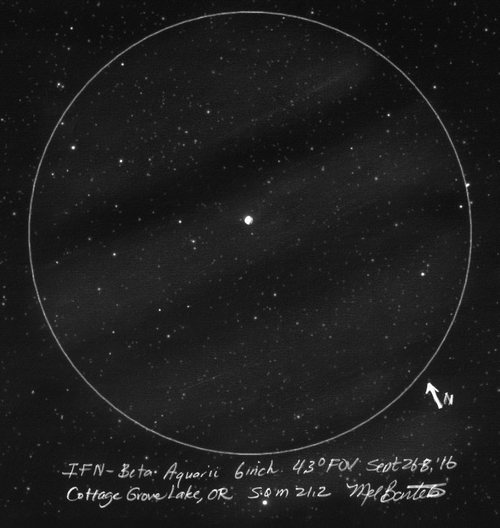
Herschel region #48 NW of Enif
RA 21:40 Dec 10:15
Size 1/2x1/2 deg
Visibility: medium
Description: Oval patch devoid of stars; seen immediately with a 30 inch.

N of Enif
RA 21:45 Dec 10:55
Size 1/4x1/4 deg
Visibility: faint
Description: smaller and faint patch seen while inspecting Herschel's region #48; seen immediately with a 30 inch.

Alpha Aquarii
RA 22:05 Dec -0:20
Size 3x4 deg
Visibility: faint
Description: Two bight unaided-eye stars to the W of the Aquarius propeller; streamers as is common in this part of the sky with a faint band at right angles; interesting view.
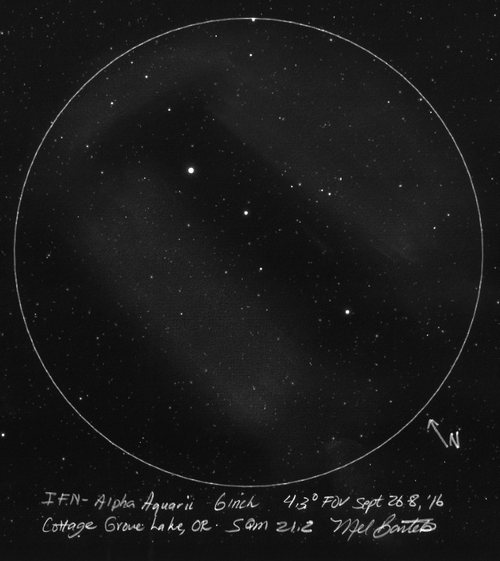
Mu Pegasi
RA 22:50 Dec 24:40
Size 4x4 deg
Visibility: medium
Description: Mu Pegasi is one of the two stars visible to the unaided eye to the SW of the upper right corner of Pegasus; the IFN is part of a complex that stretches southward through Alpha Pegasi; star in a dark region; overall shape is a 'hat' with the western side brightest. Herschel region 51.
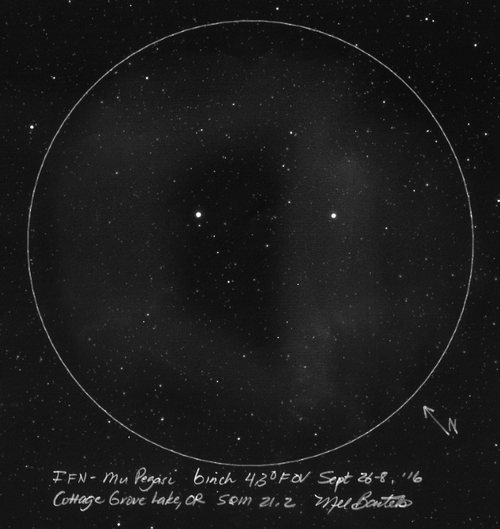
Beta Pegasi
RA 23:00 Dec 28
Size 2x2 deg
Visibility: medium
Description: V' shaped cloud that traverses an chain of stars to the SE; other side of the 'V' extends through the star; pretty definite edges as far as IFN go. Herschel region 52.
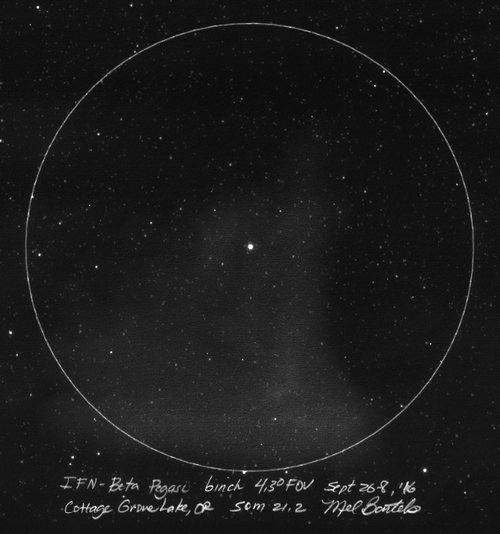
Alpha Pegasi
RA 23:00 Dec 15:10
Size 4x4 deg
Visibility: medium
Description: Brightest broad band to the south with fainter portions that surround Markab creating a dark middle; bands broad with indistinct edges.
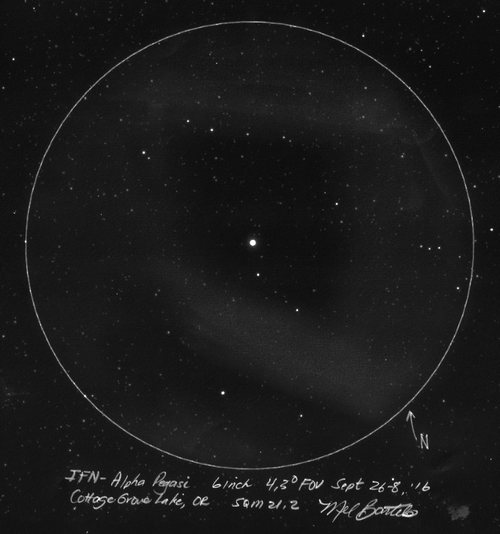
NGC 7497
RA 23:10 Dec 18:10
Size 1/4x1/2 deg
Visibility: faint
Description: S' shape through galaxy; extensions in multiple directions.
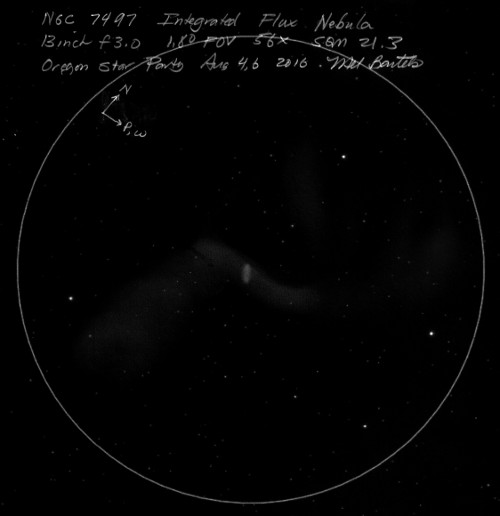
Pisces head - west side
RA 23:25 Dec 05:00
Size 2x4 deg
Visibility: medium
Description: Curved arc with some detail inside the head; two curved arcs outside the head to the NW, the outermost arc the brightest; pretty sight.
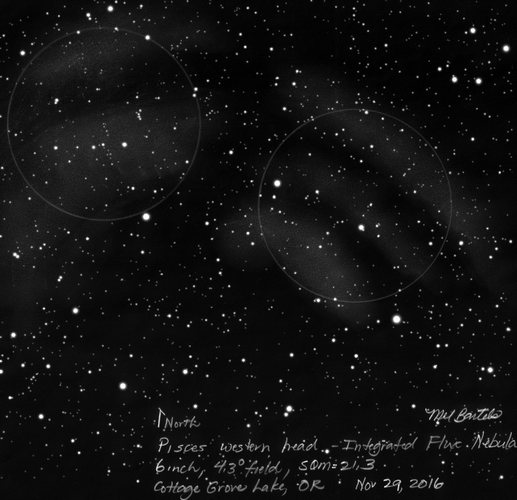
Pisces head - east side
RA 23:40 Dec 05:30
Size 2x4 deg
Visibility: medium
Description: Large arcs NE of Iota Piscium; the arcs merge on the east side and head south.

NGC 7771, 7769
RA 23:50 Dec 20:15
Size 1x1 deg
Visibility: medium
Description: Region of complex IFN next to the two galaxies NGC 7771 adn 7769.
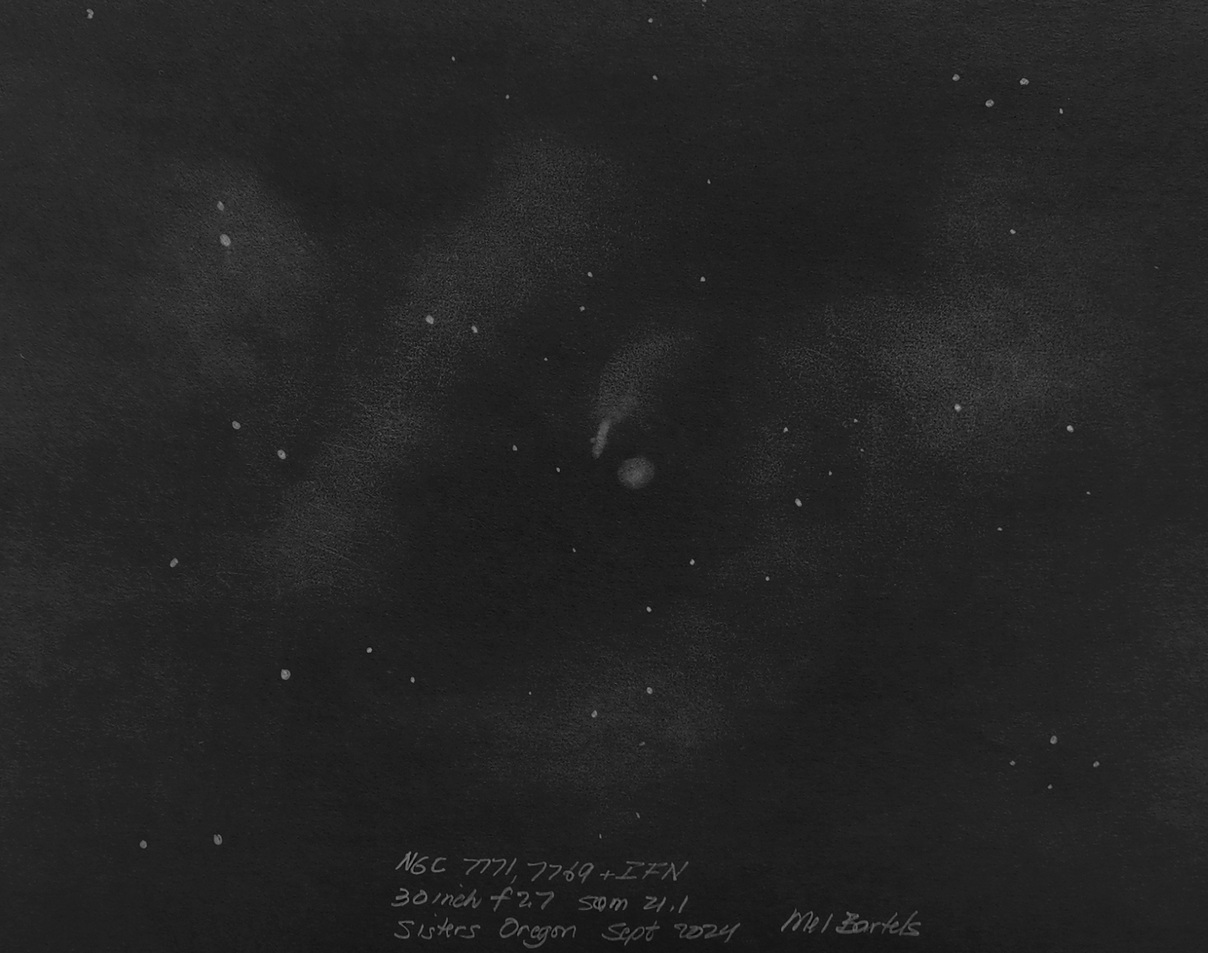
eod of document










































































































































































